This post may contain affiliate links. For more information, please see our affiliate policy.
Danish Layer Cake is a specialty dessert popular in Racine, Wisconsin. It has 7 layers of total of soft vanilla cake, homemade pastry cream, and raspberry jam, all covered in a luscious vanilla buttercream frosting.
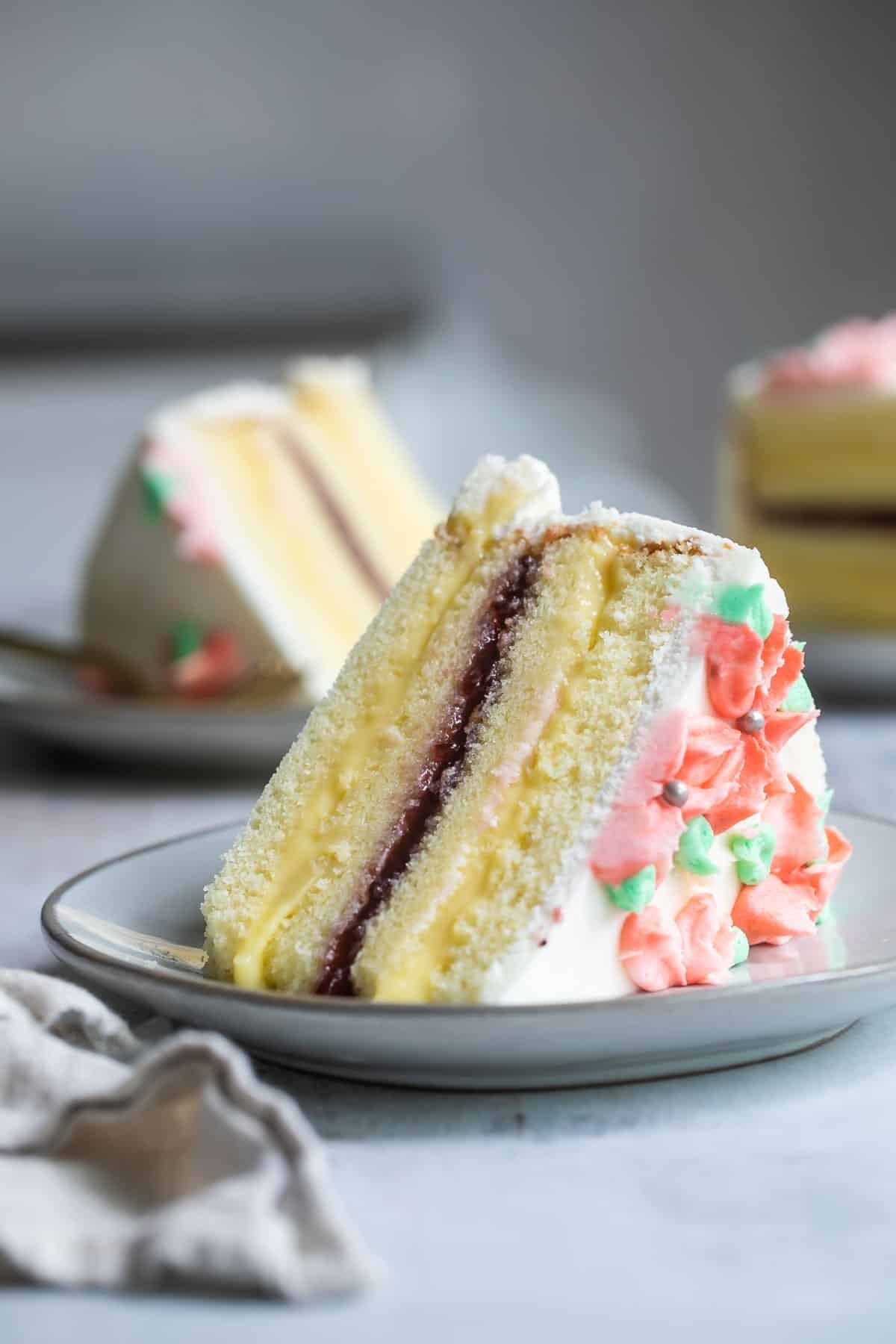
When I was growing up, I loved it when my mom made me Danish Layer Cake for my birthday.
Her side of the family is from a town called Racine, Wisconsin (home to Danish Bakery legend O&H), so Danish Layer Cakes were part of the fabric of her childhood.
She made things easy by starting with a boxed mix, but I’m returning this cake to it’s full glory with full-on from-scratch status.
Table of Contents
Recipe ingredients
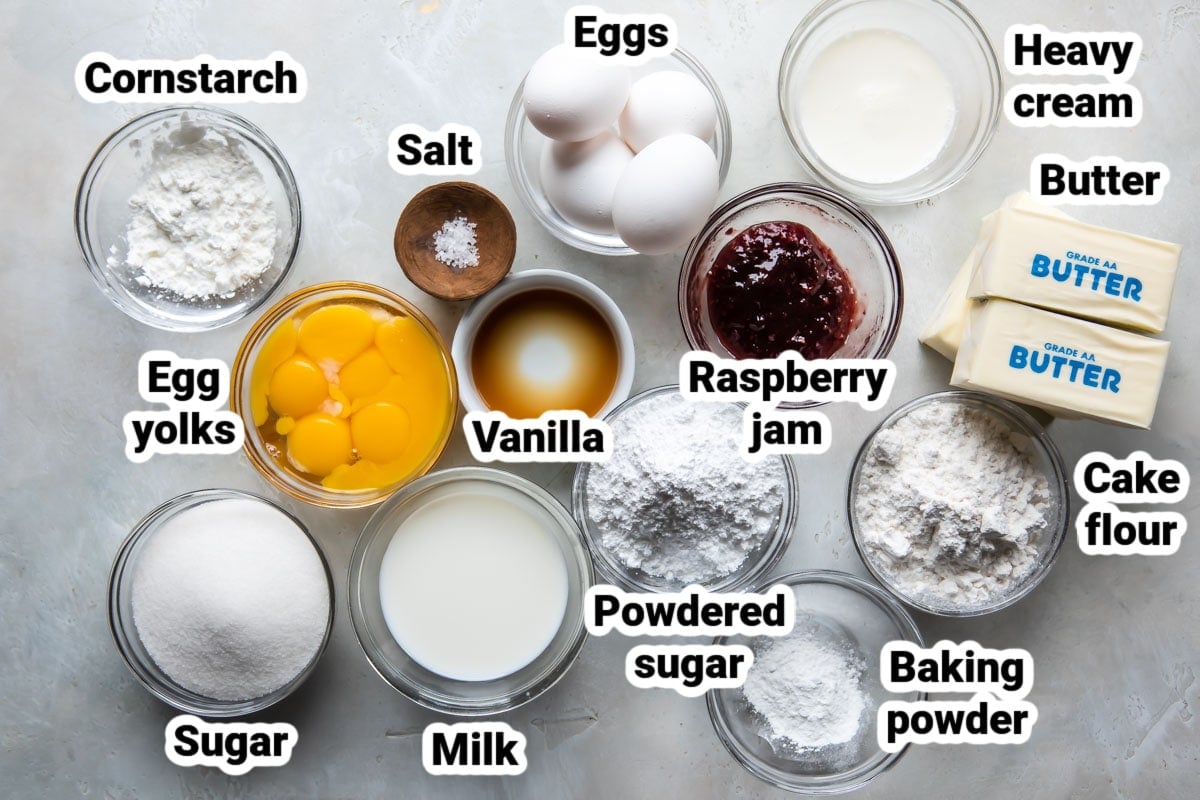
At a Glance: Here is a quick snapshot of what ingredients are in this recipe.
Please see the recipe card below for specific quantities.
Equipment and ingredient notes
- 8-inch cake pans: Do not substitute 9-inch cake pans.
- Whole milk: Do not substitute low-fat milk for the whole milk in the vanilla cake.
- Seedless raspberry jam: If you cannot track this down, raspberry jam with seeds, or another seedless jam, may be substituted. Strawberry seedless jam tastes great in this cake.
Step-by-step instructions
To make the pastry cream:
- In a medium non-aluminum saucepan over medium heat, warm milk until tiny bubbles appear on the surface, about 6 to 8 minutes (about 180 degrees Fahrenheit/82 degrees Celsius).
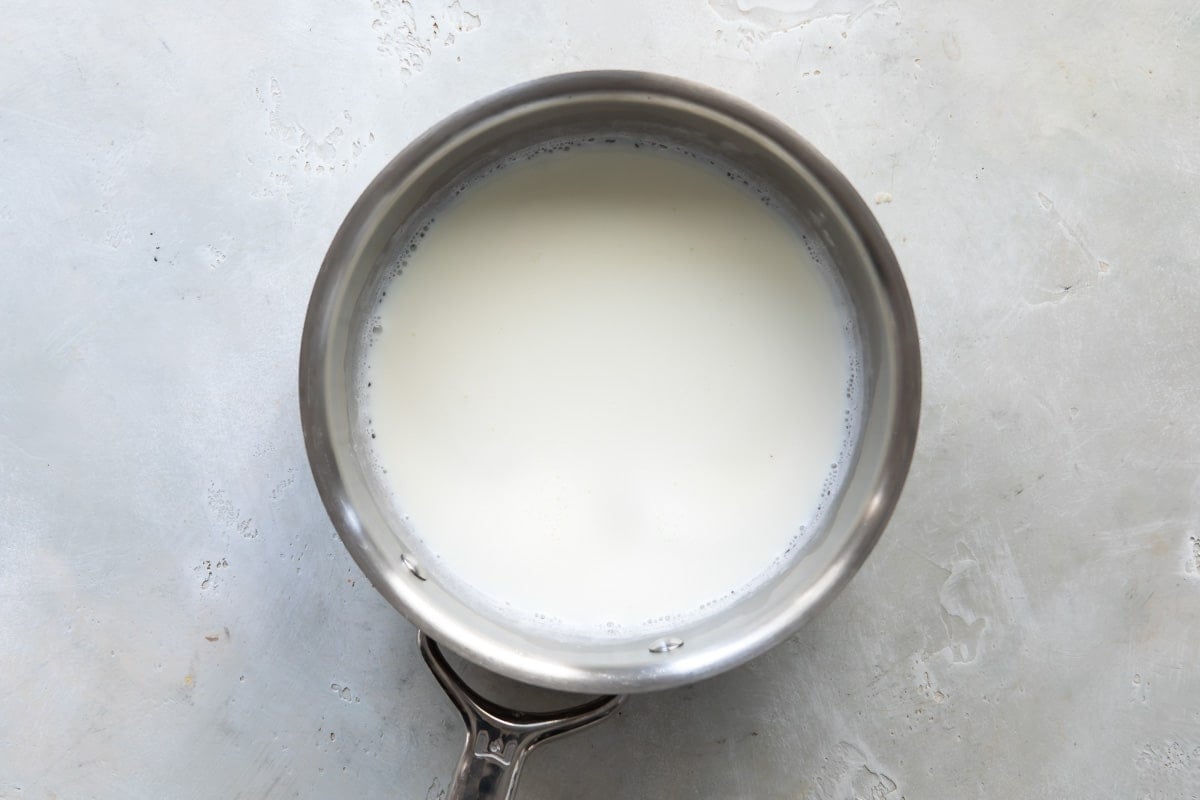
- Meanwhile, In a large bowl, whisk together egg yolks and sugar. Whisk in cornstarch and salt.
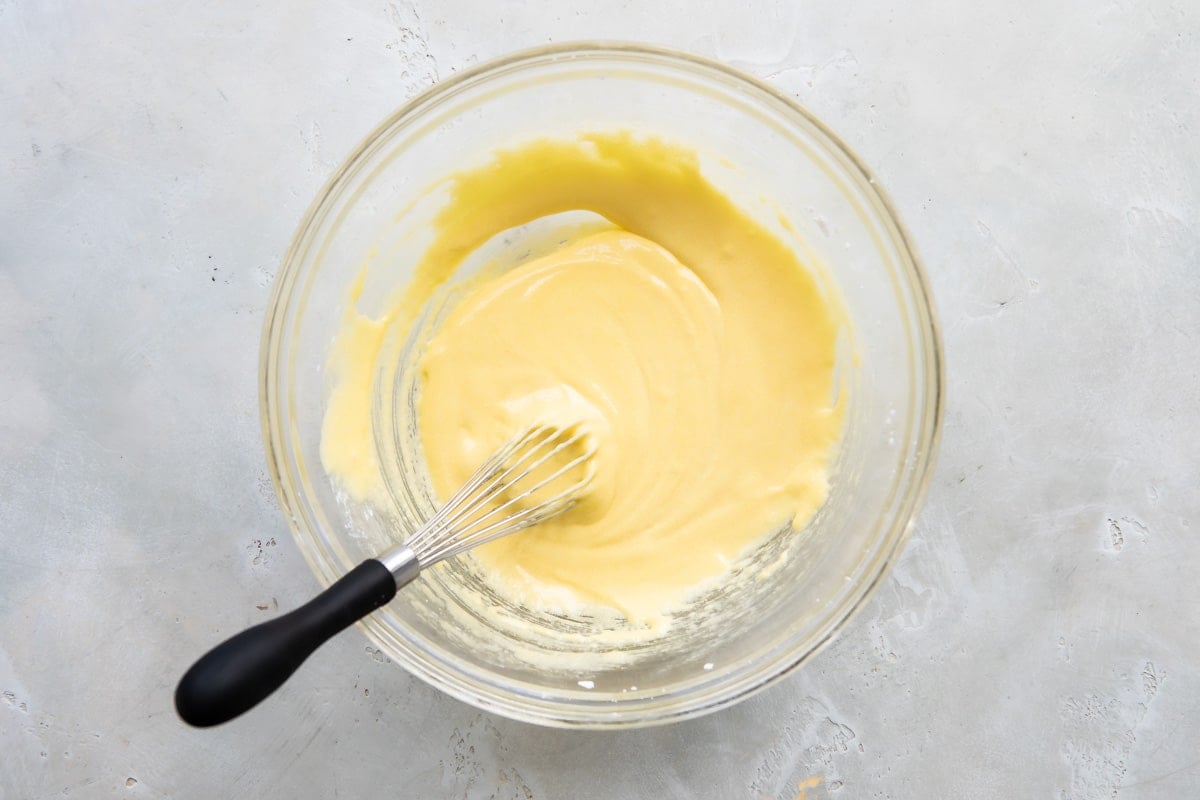
- While whisking constantly, pour in half of the hot milk.
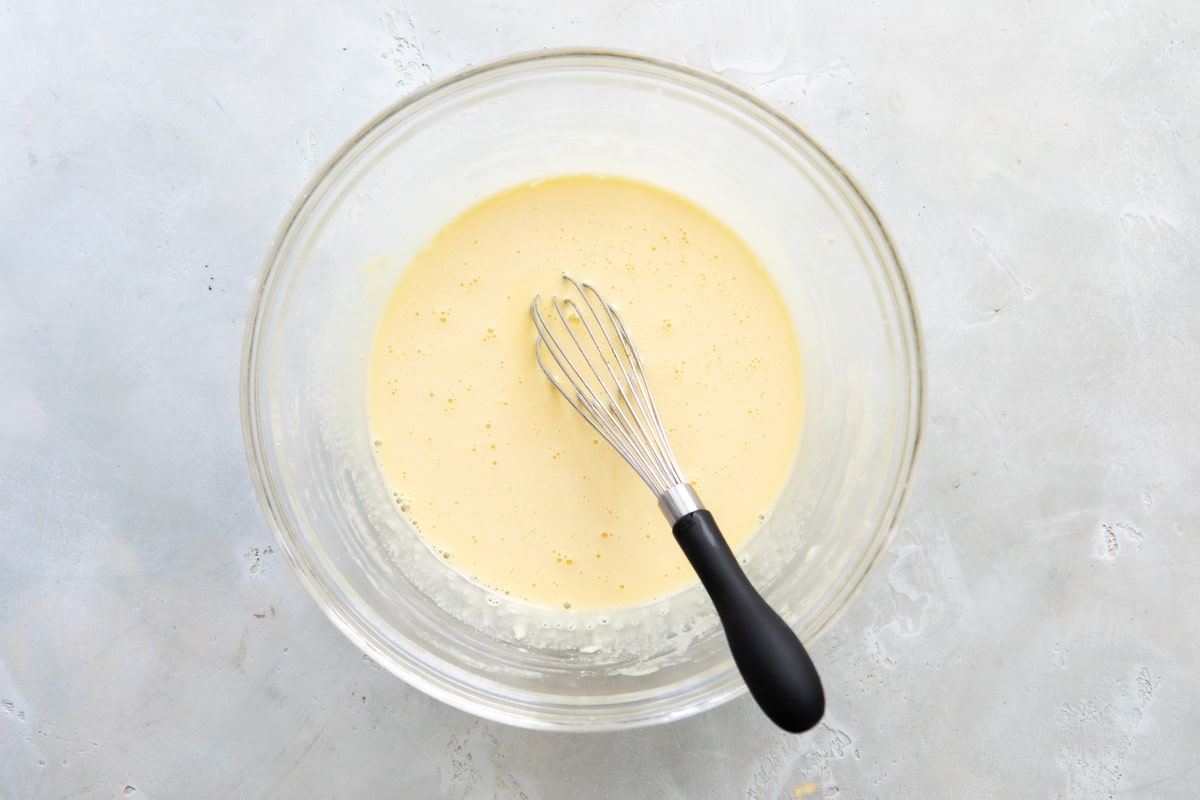
- Whisk in remaining hot milk and return to saucepan.
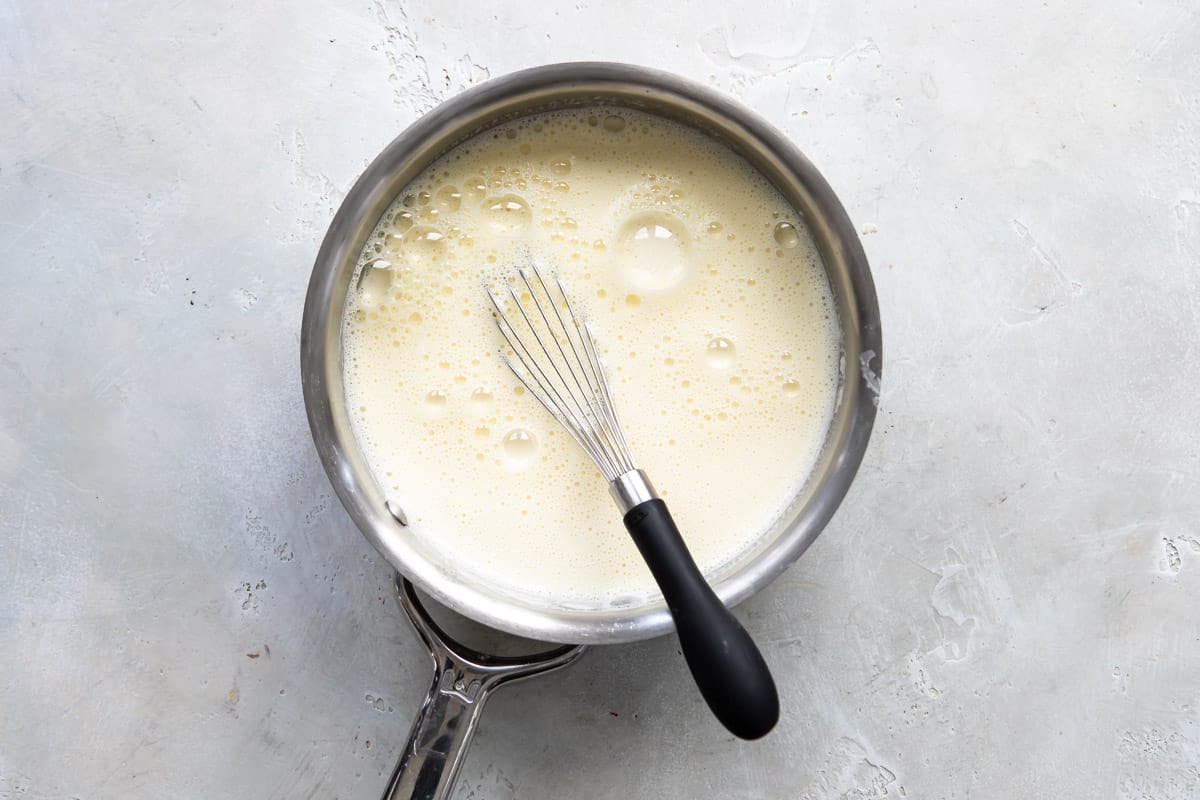
- Cook over medium heat, whisking constantly, until the mixture thickens to a firm consistency, about 5 to 8 minutes.
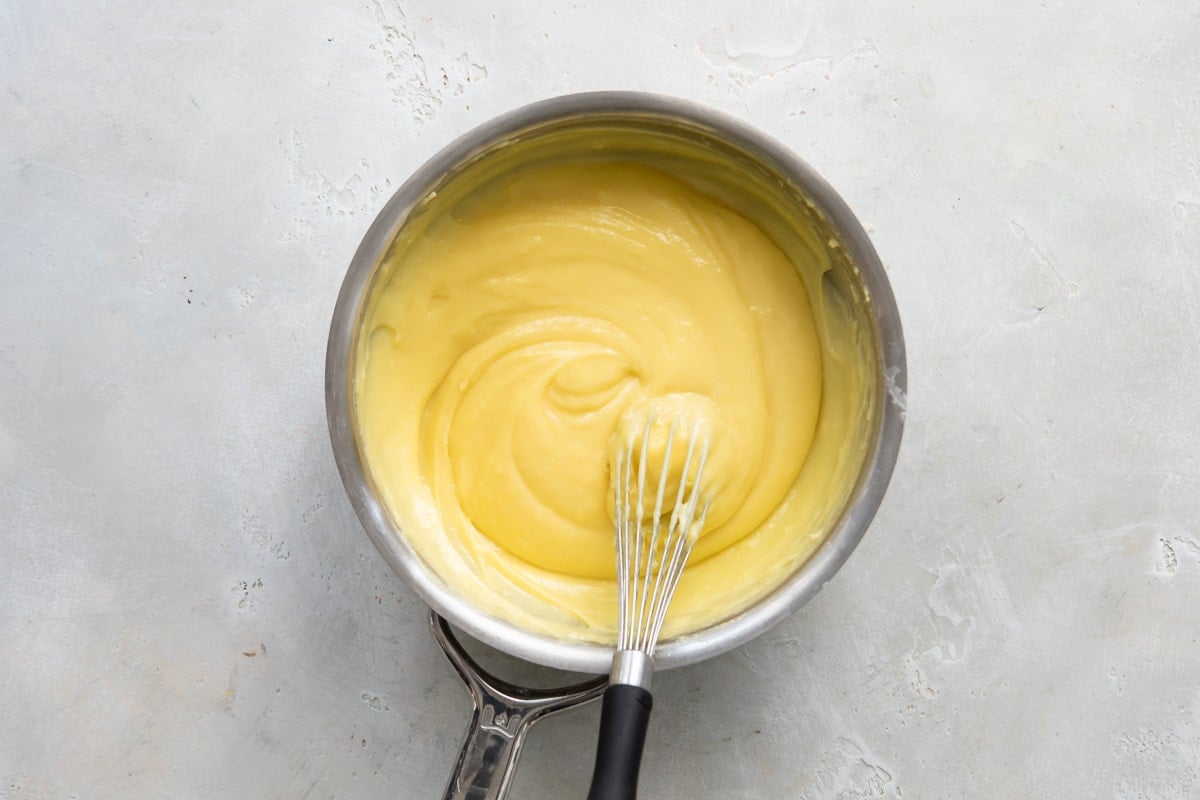
- Whisk in vanilla. Scrape in to a bowl. Cover with plastic wrap, pressing it directly on to the surface of the pastry cream.
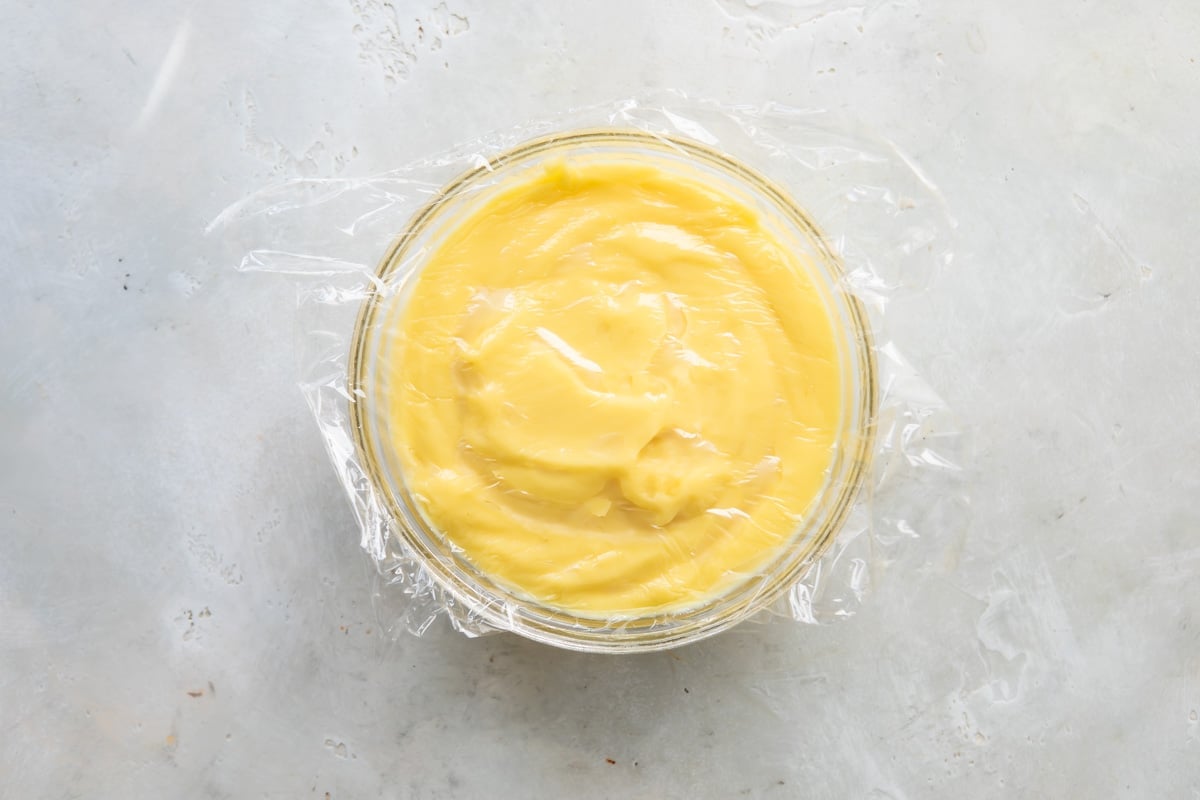
- Refrigerate until chilled, about 2 to 3 hours. (Note: You will have just over 2 cups of pastry cream and you only need about 1 ½ cups for this recipe.)
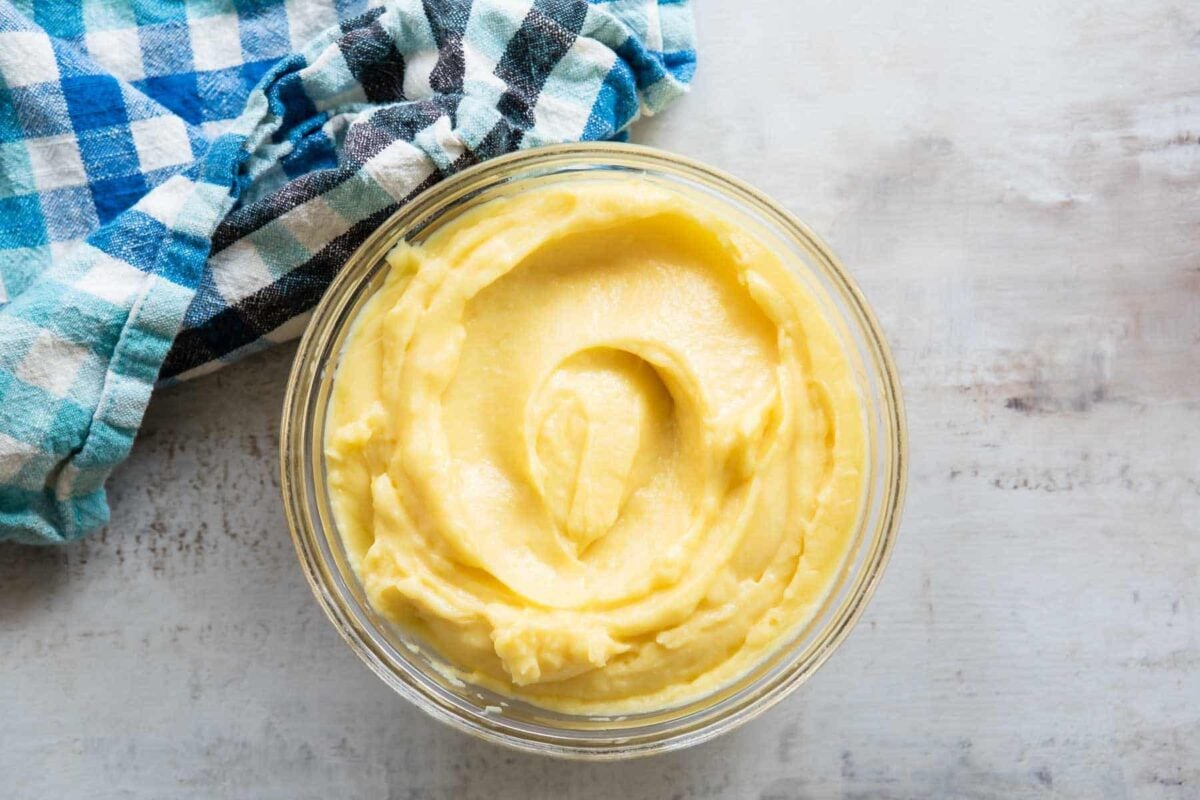
To make the cake:
- Preheat oven to 350 degrees. Grease and flour 2 (8-inch) round cake pans, then line parchment paper. In a small bowl, whisk together milk, eggs, and vanilla. Set aside.
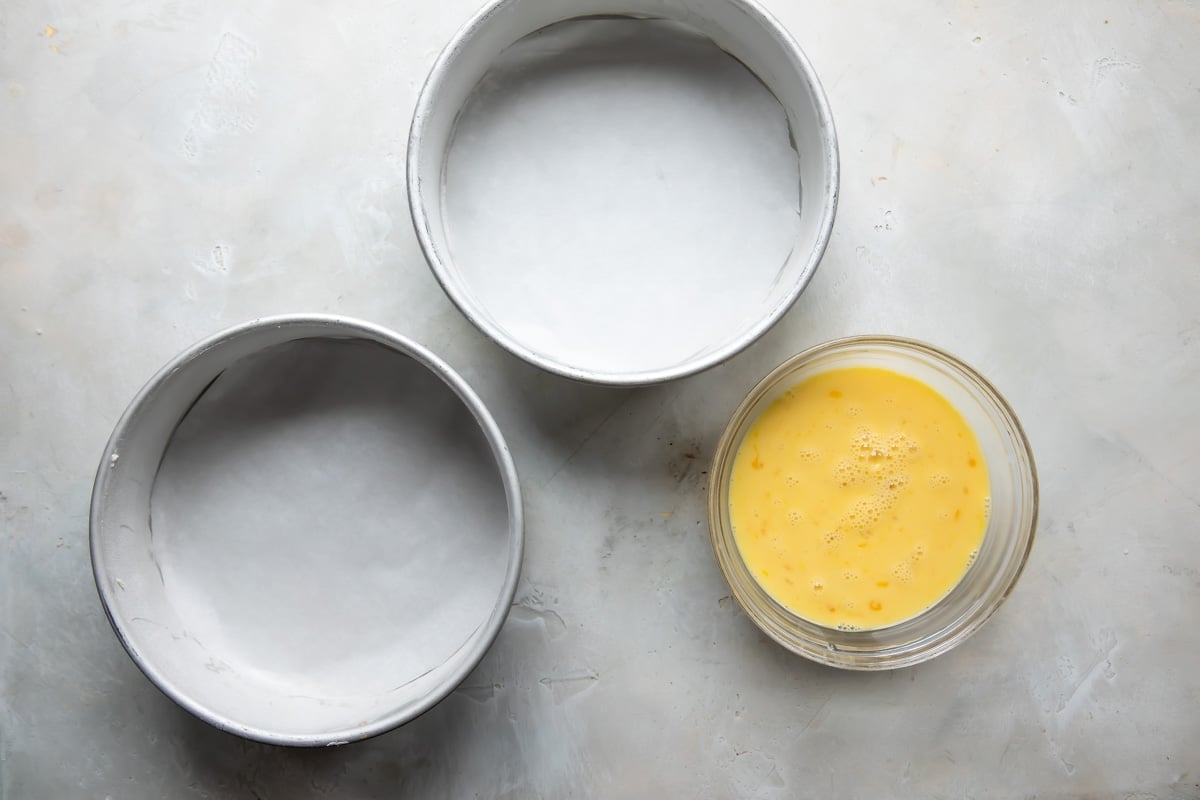
- In the bowl of a standing mixer fit with the whisk attachment, beat together flour, sugar, baking powder, and salt.
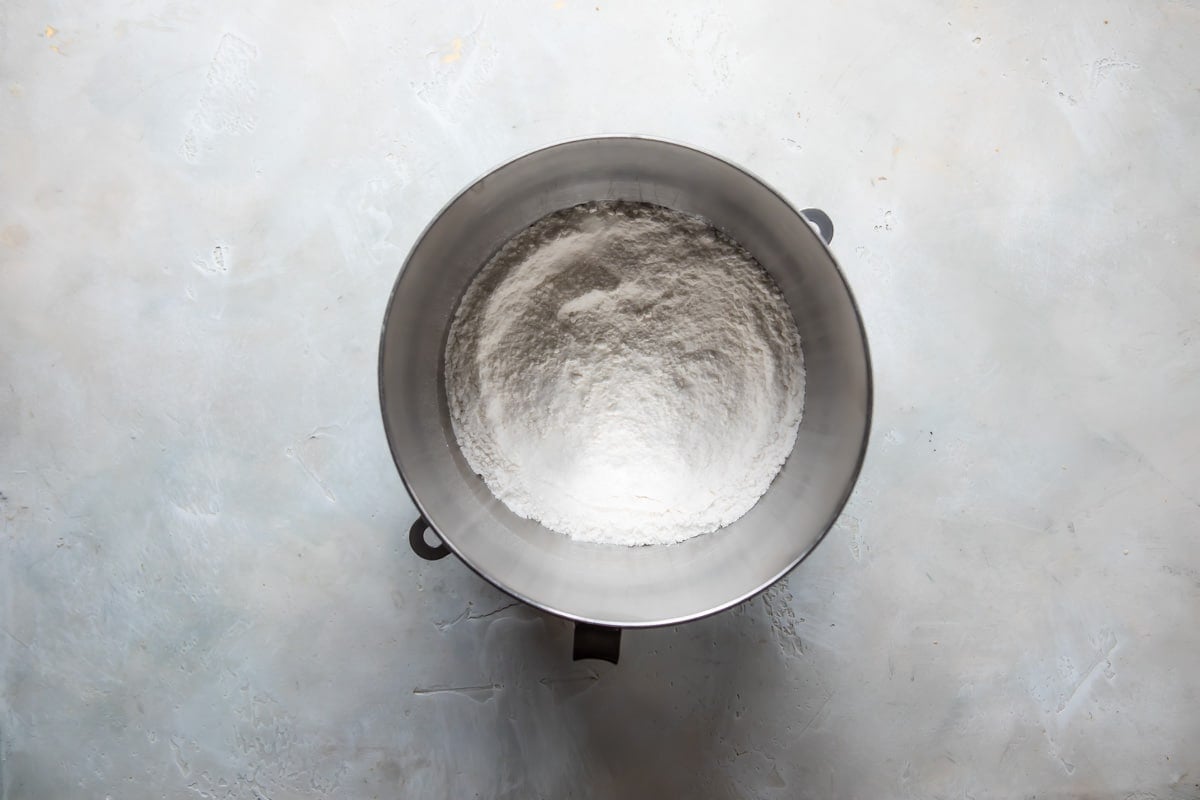
- With the mixer on medium-low speed, beat the butter in to the flour mixture one piece at a time. Continue beating until the mixture resembles moist crumbs, 1 to 3 minutes total.
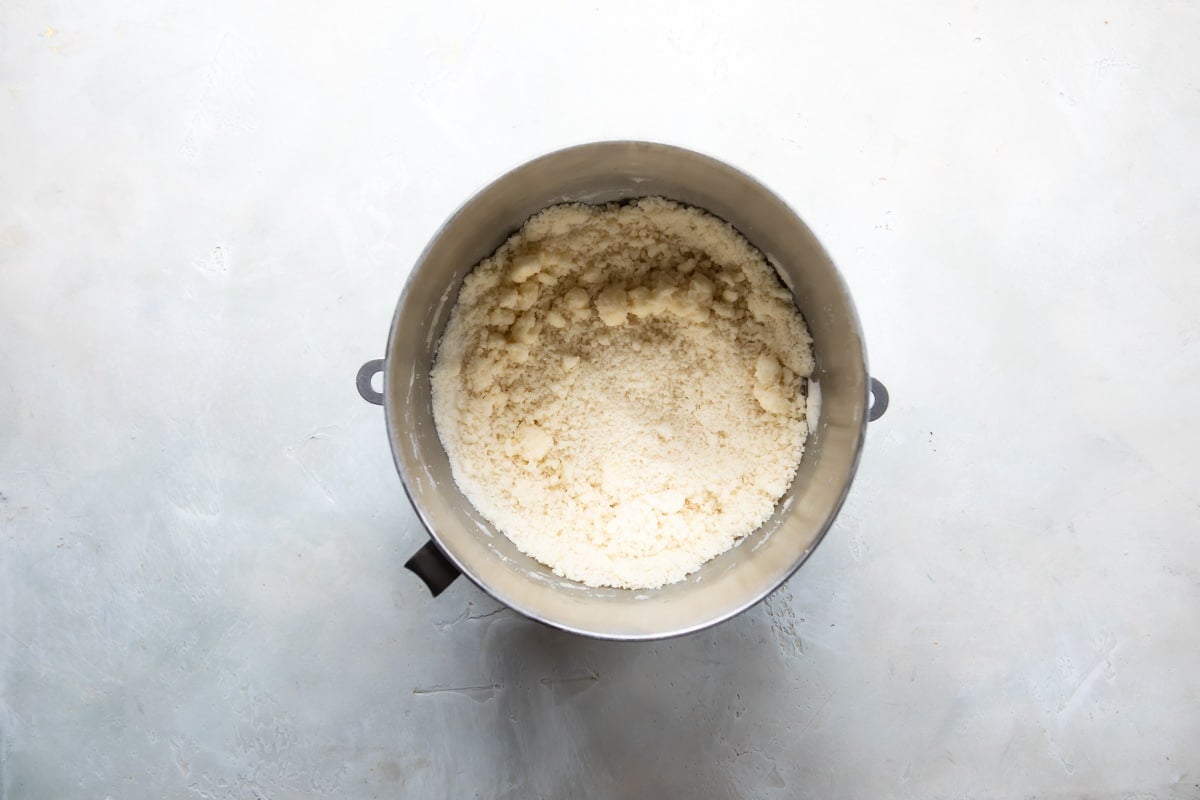
- Add the milk mixture to the mixer and beat until light and fluffy, 1 to 3 minutes longer. Stir by hand with a rubber spatula to make sure the batter is fully combined.
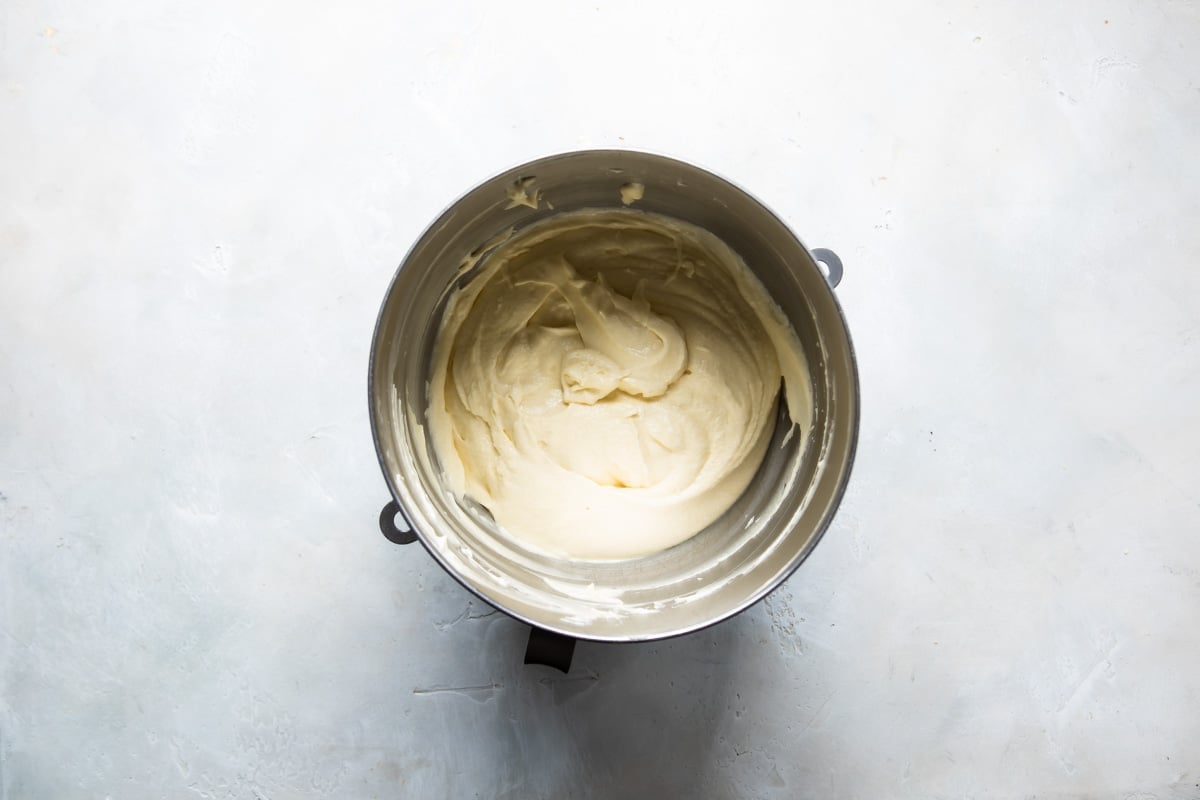
- Divide the batter evenly between both pans, gently tapping the pans on the counter to settle the batter. Bake until a toothpick inserted in the center of the cake comes out dry with a few crumbs attached, 20 to 25 minutes. Rotate the pans halfway through baking time.
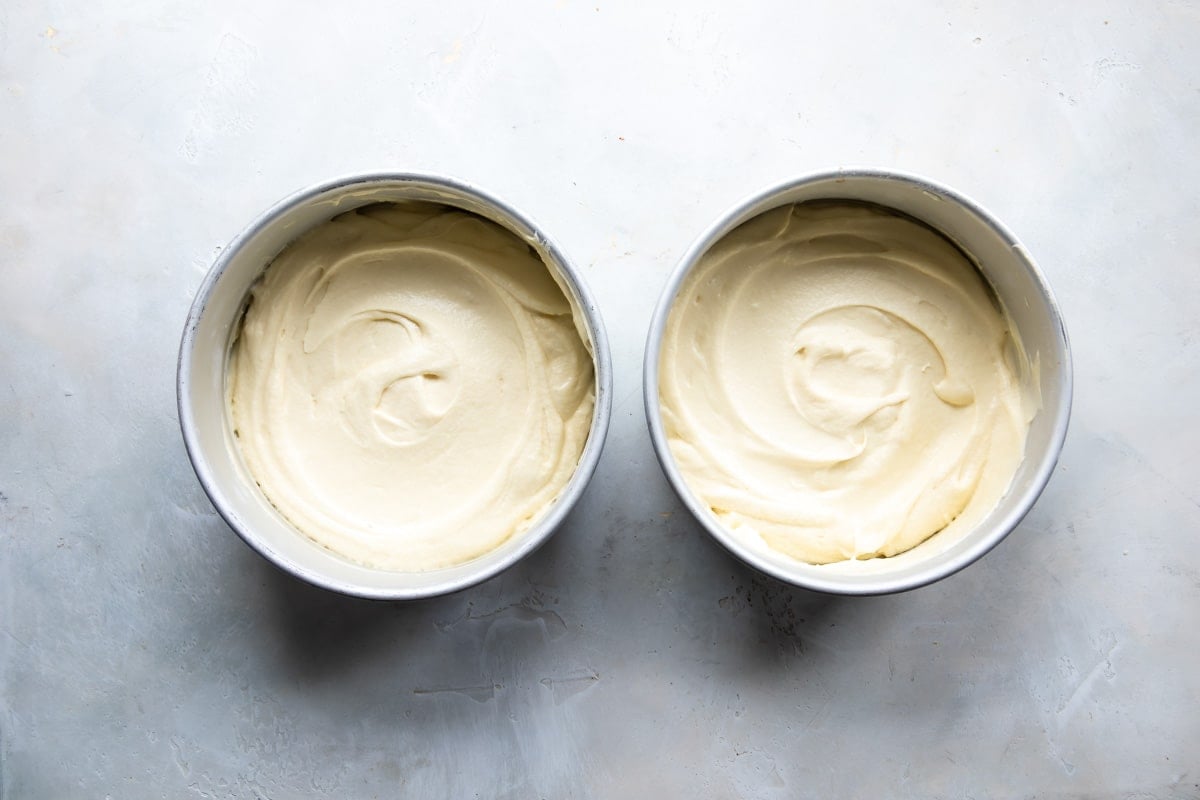
- Cool the cakes in the pans for 10 minutes.
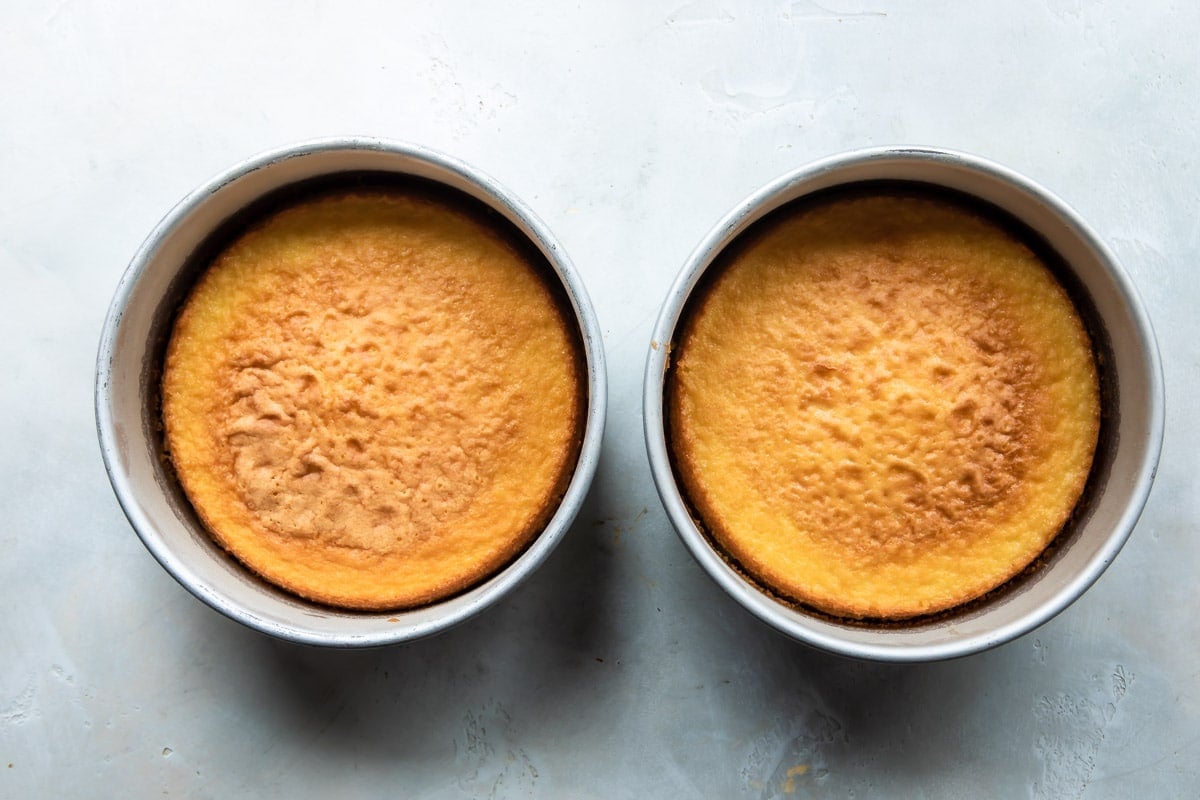
- Run a small sharp knife around the inside of each pan to loosen, then flip the cakes on to a wire rack. Peel off the parchment paper, then flip the cakes right side up to cool completely, about 2 hours.
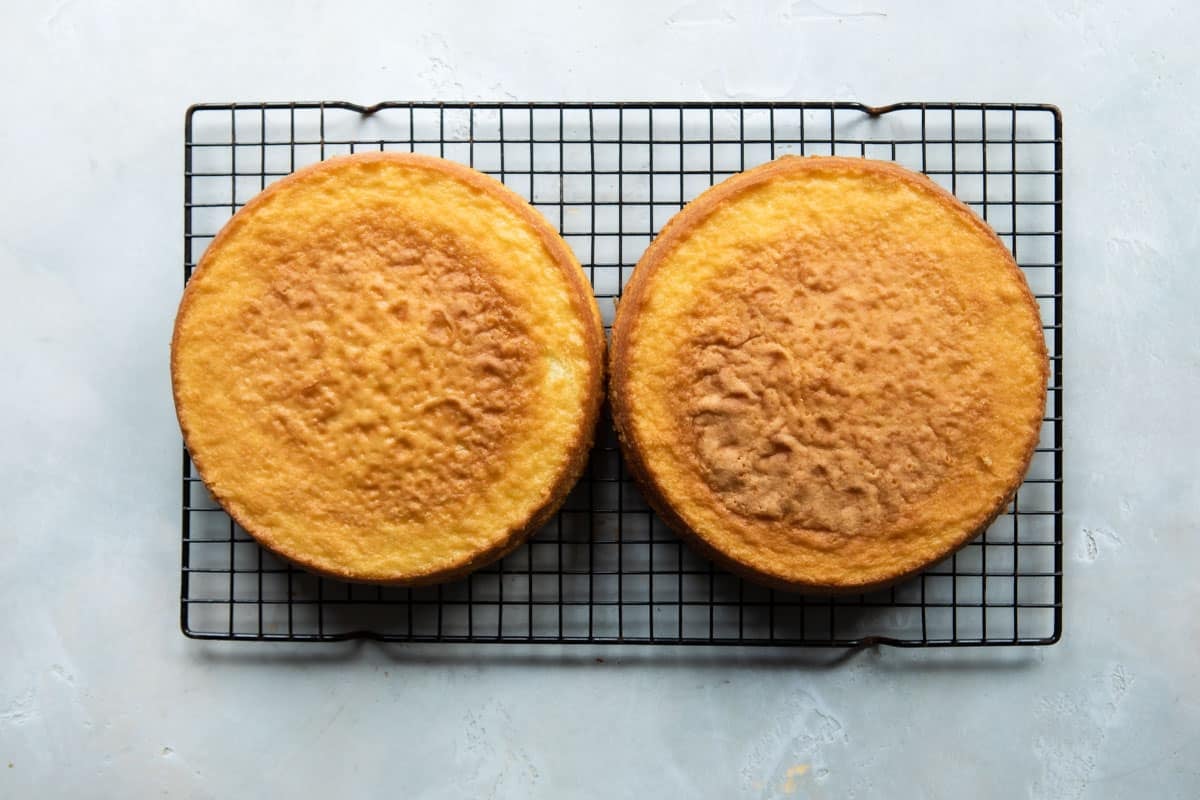
To make the frosting:
- In a standing mixer fit with the paddle attachment, cream butter until pale and fluffy, about 3 minutes. Reduce mixer speed to low. Add 4 cups powdered sugar, cream, vanilla, and salt (if using).
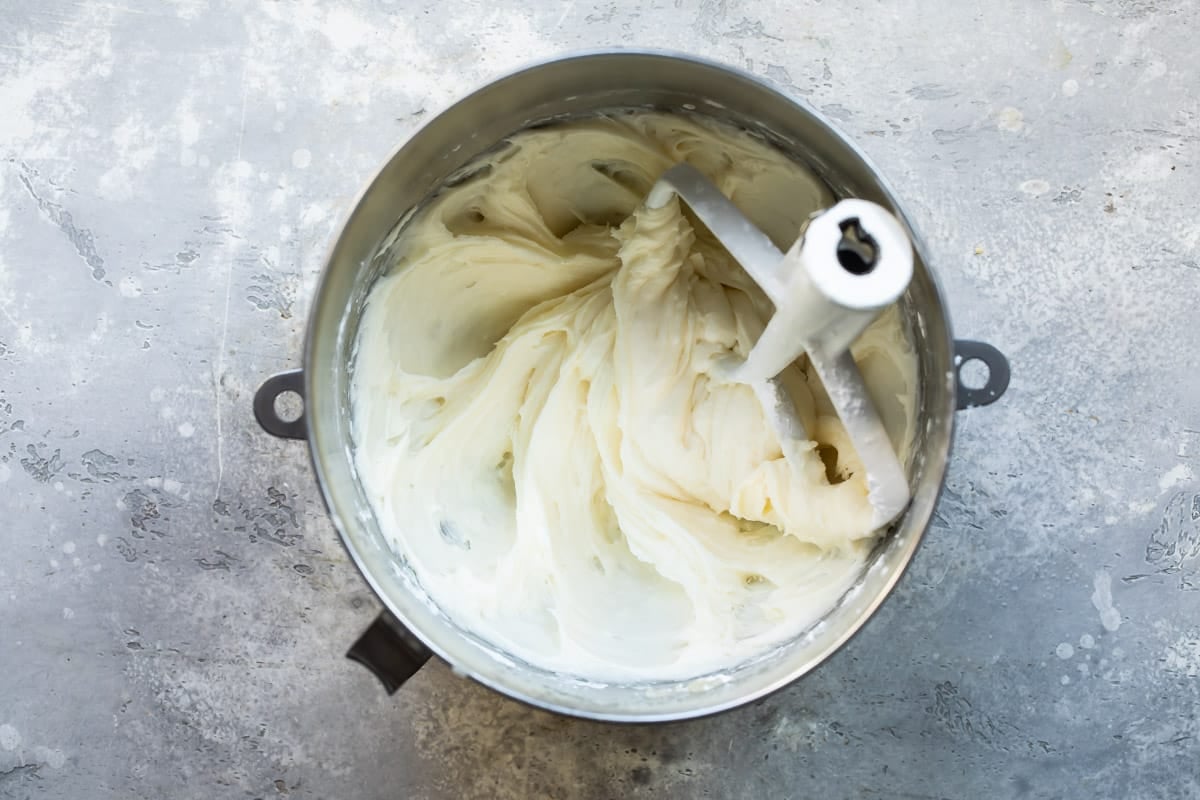
- Continue mixing 2 to 3 minutes longer. If the frosting seems too soft, add the remaining powdered sugar 2 tablespoons at a time.
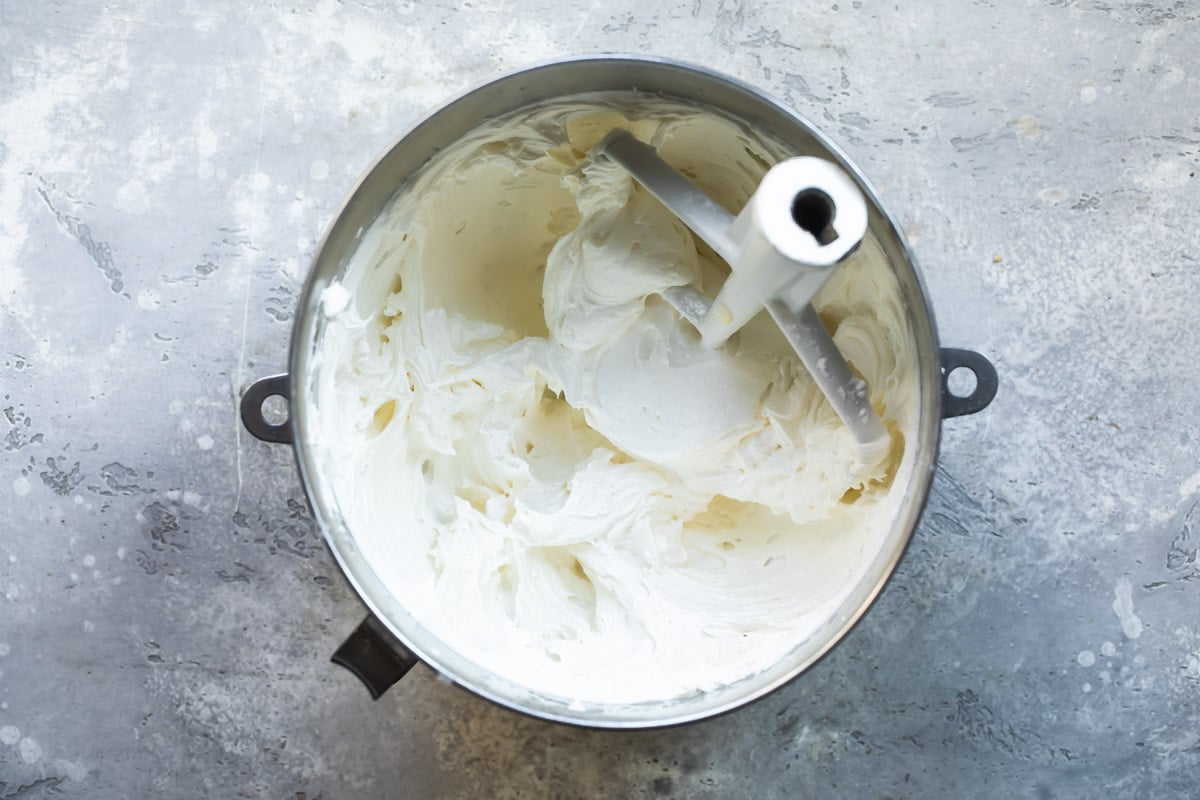
- Cover and refrigerate the frosting until assembling the cake, up to 1 week in advance.
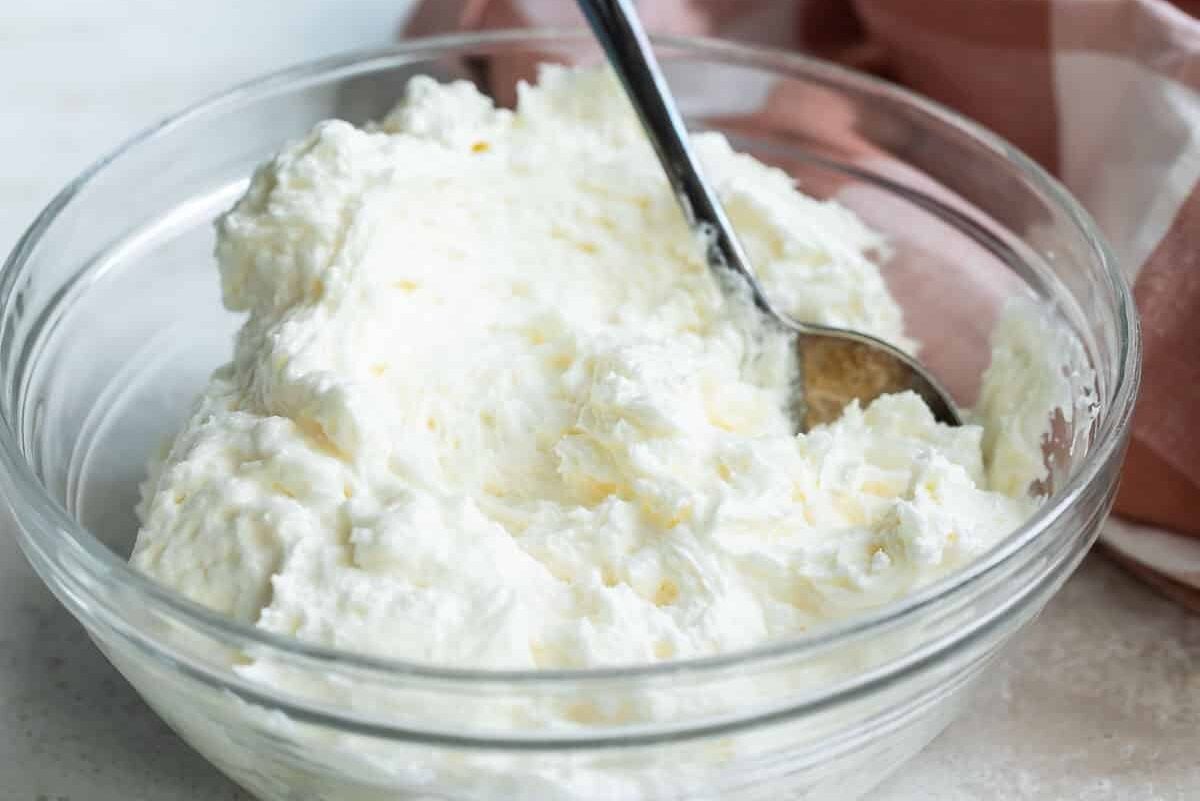
To assemble the cake:
- Slice off any domed tops of your cake to ensure they are flat.
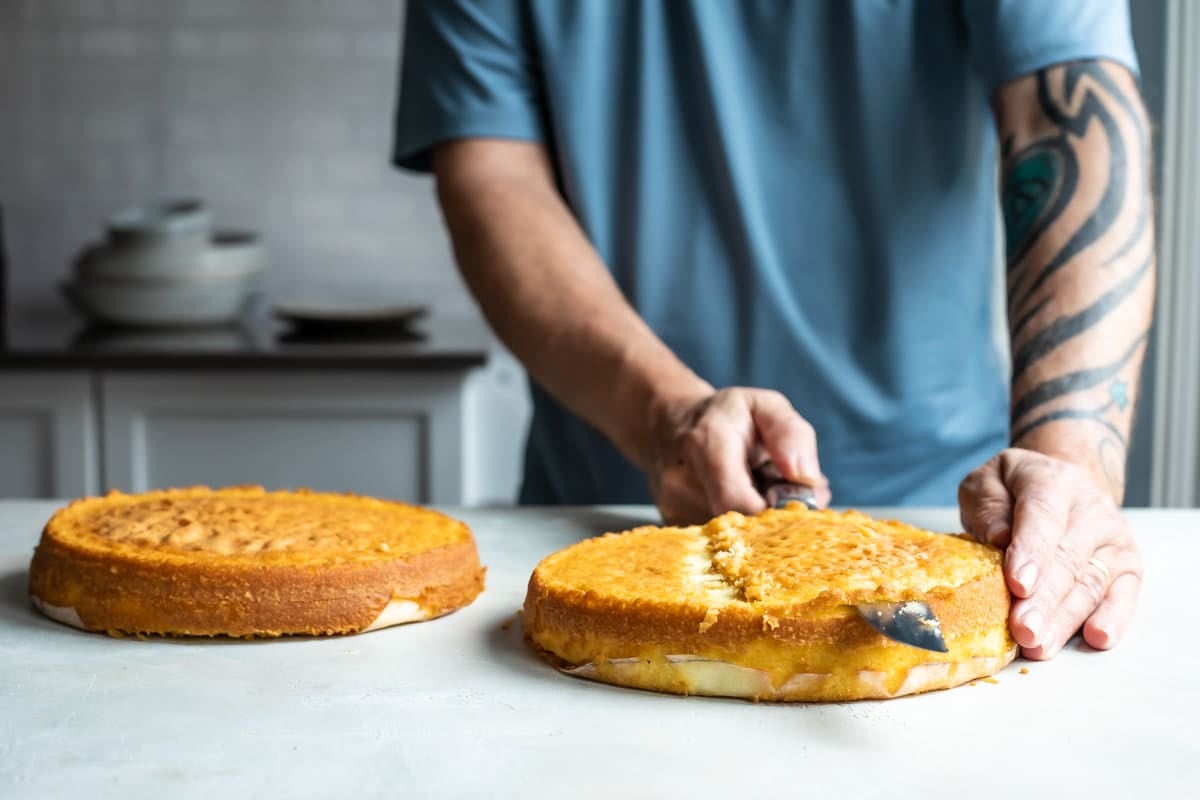
- Cut each cooled cake in half lengthwise so there are four layers of cake total.
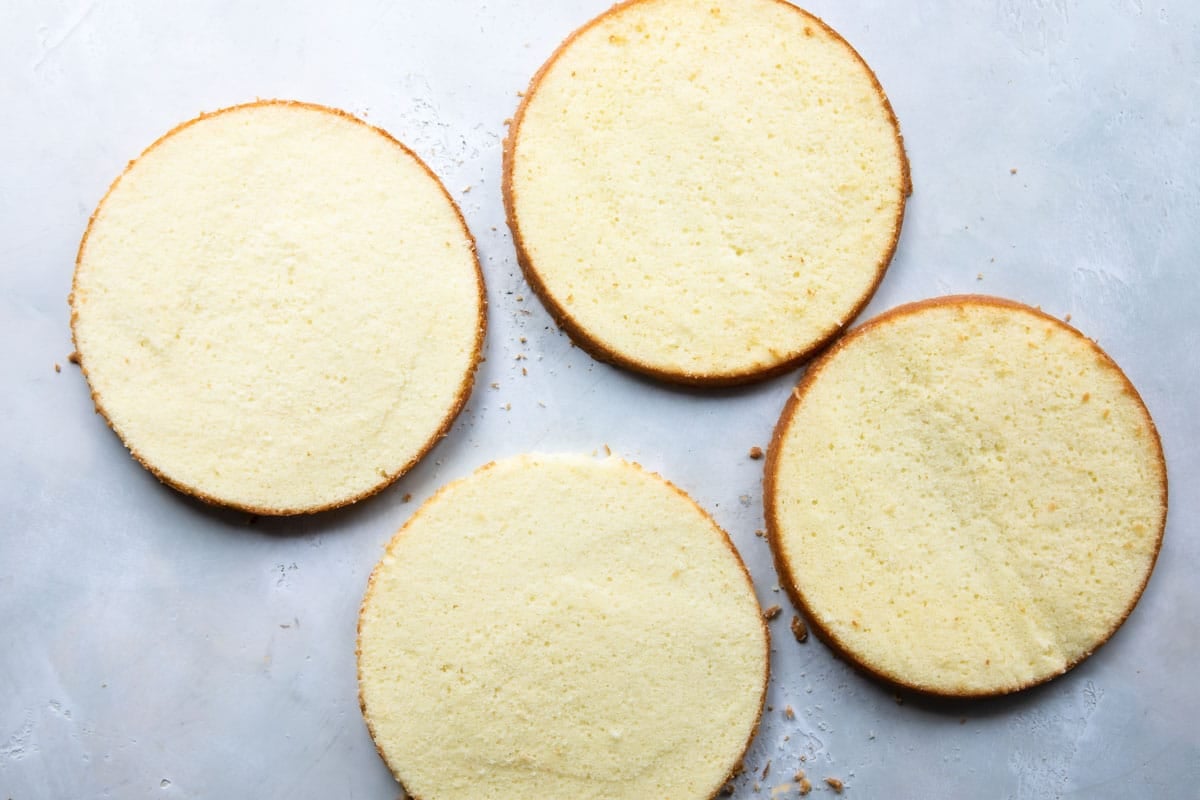
- Cover the edges of a cake platter with strips of parchment paper to help keep it clean. Slide the pieces of parchment out from under the cake once the frosting job is done.
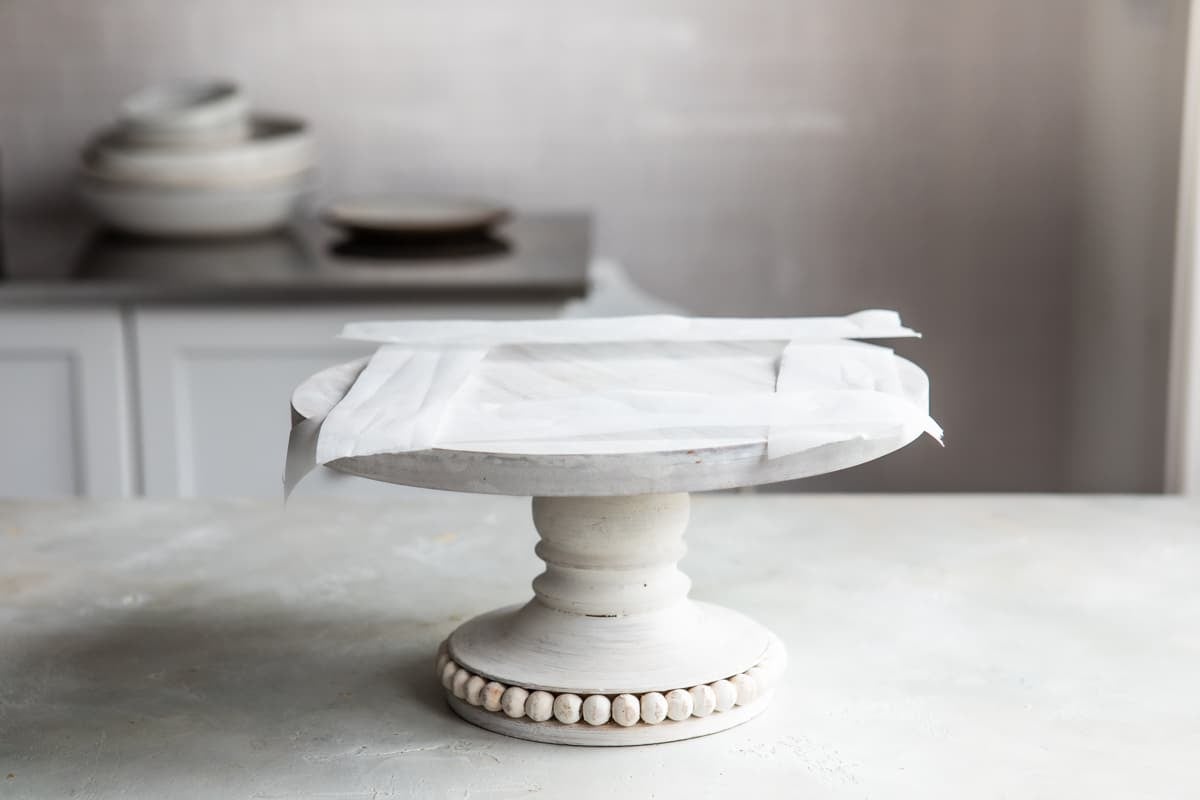
- Dollop a small amount of frosting in the center of the platter to help anchor the bottom of the cake to the platter (so it doesn’t slide around as you frost it).
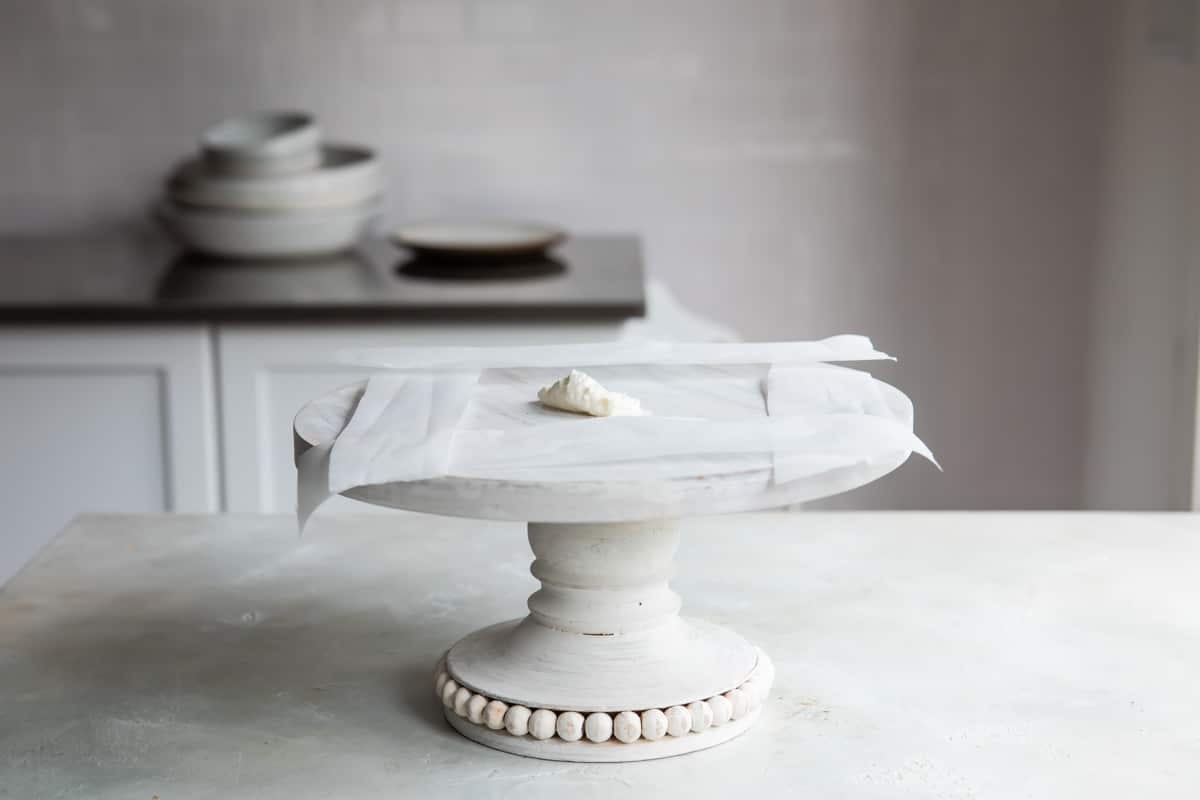
- Add one layer of cake to the serving platter. Add ¾ cup of the pastry cream to the center of the cake and spread in an even layer to the edge.
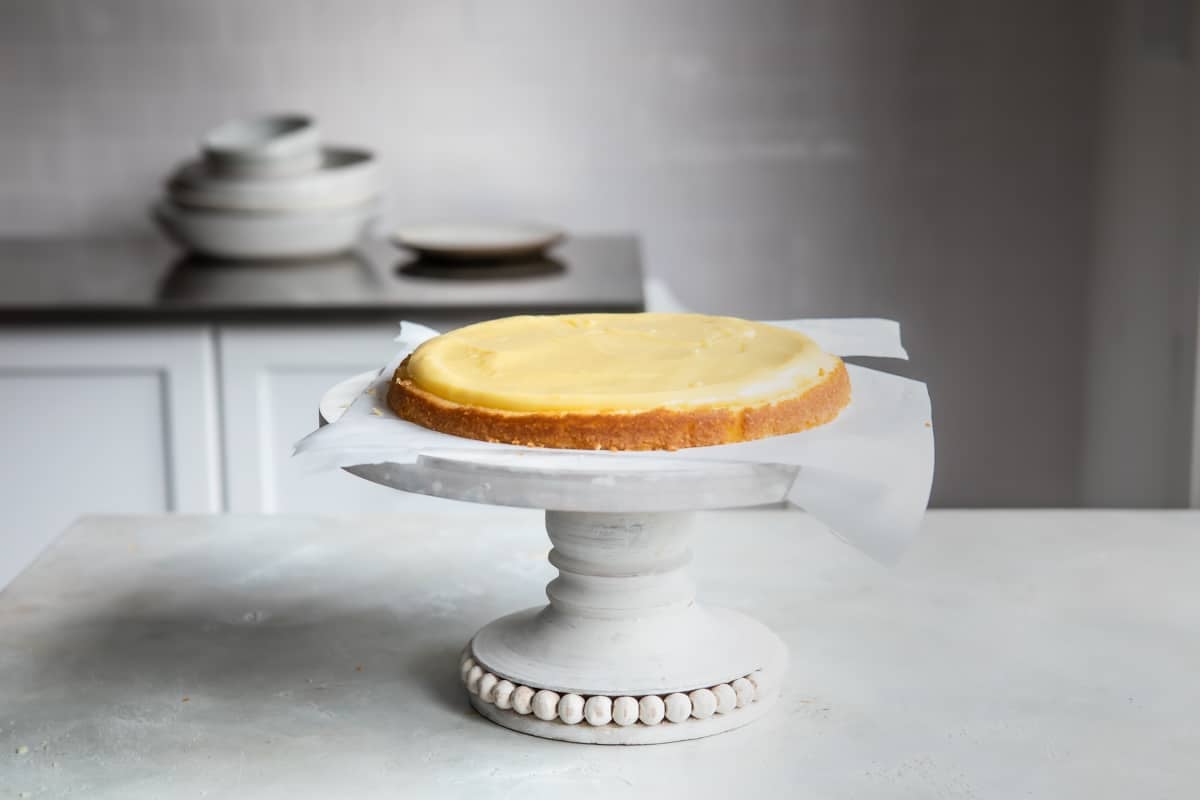
- Align a second layer of cake over the first and top with 1 cup raspberry jam, spreading in an even layer to the edge.
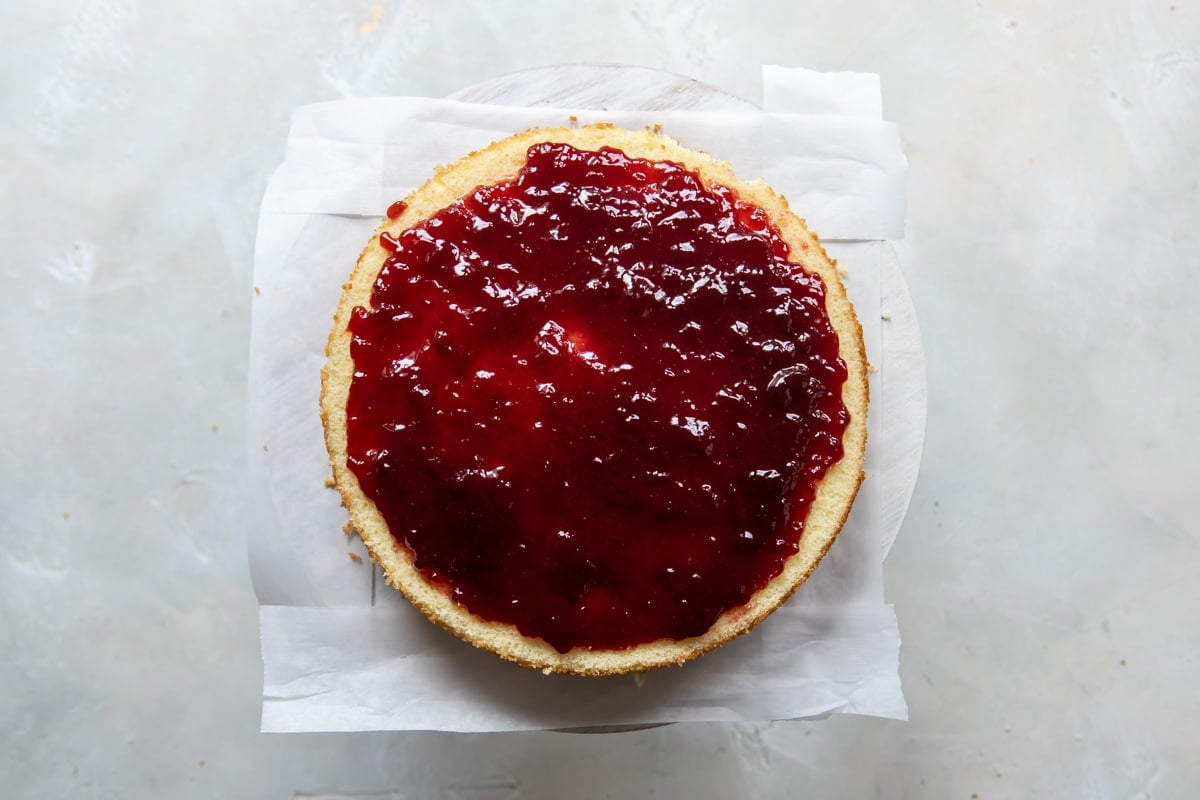
- Add a third layer of cake and top with ¾ cup of pastry cream in the center, spreading in an even layer to the edge.
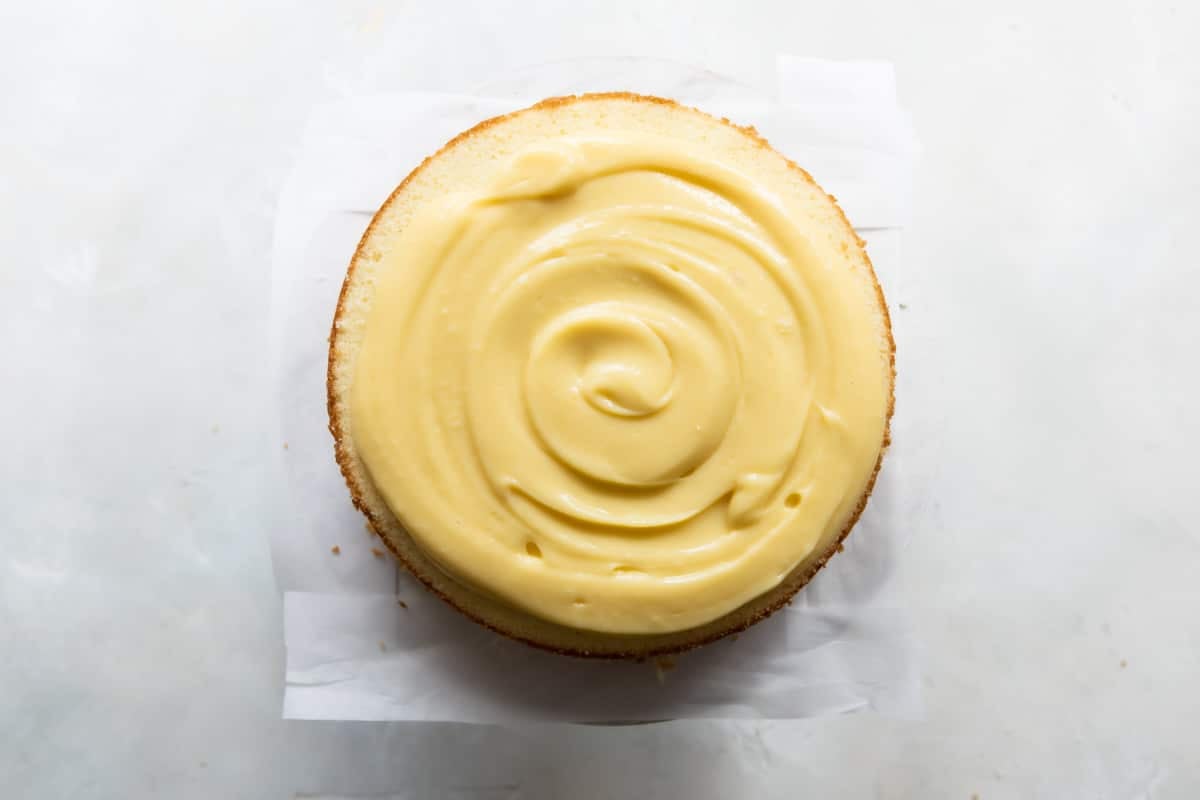
- Top with the last layer of cake.
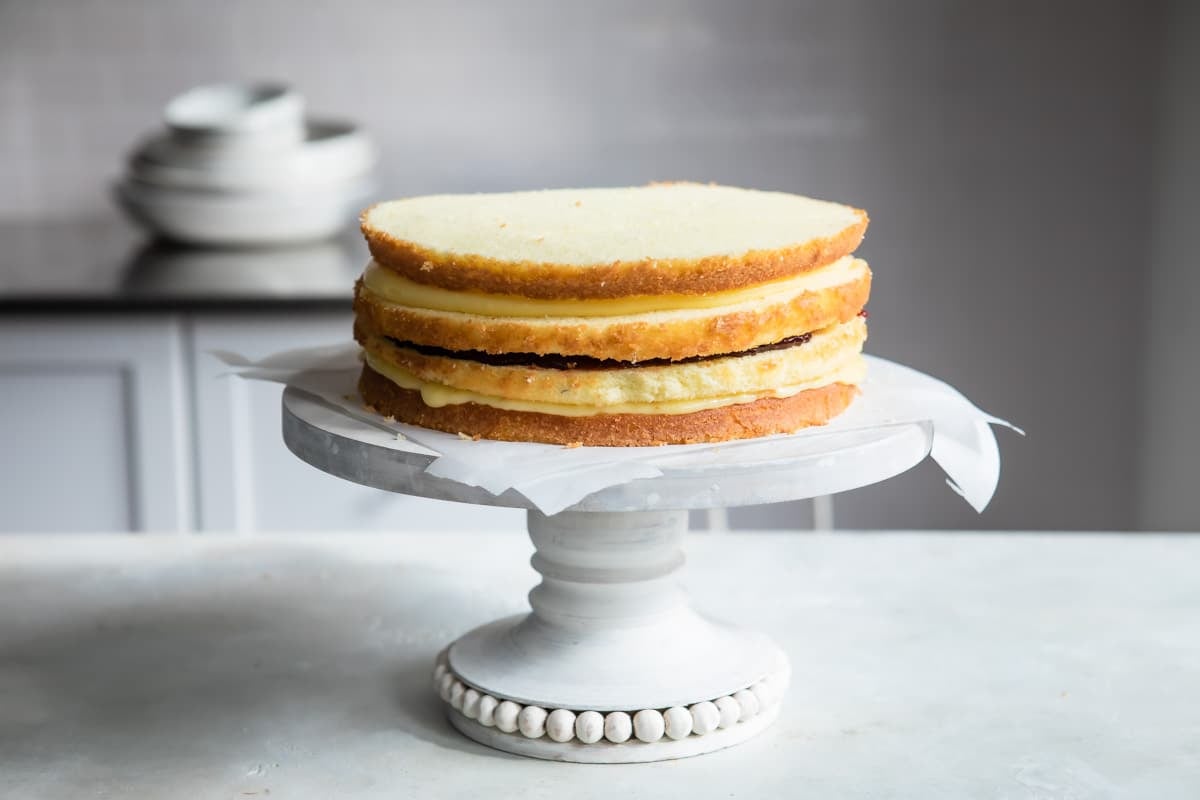
- Brush away any large crumbs, dollop frosting in the center, and spread lightly to the edges.
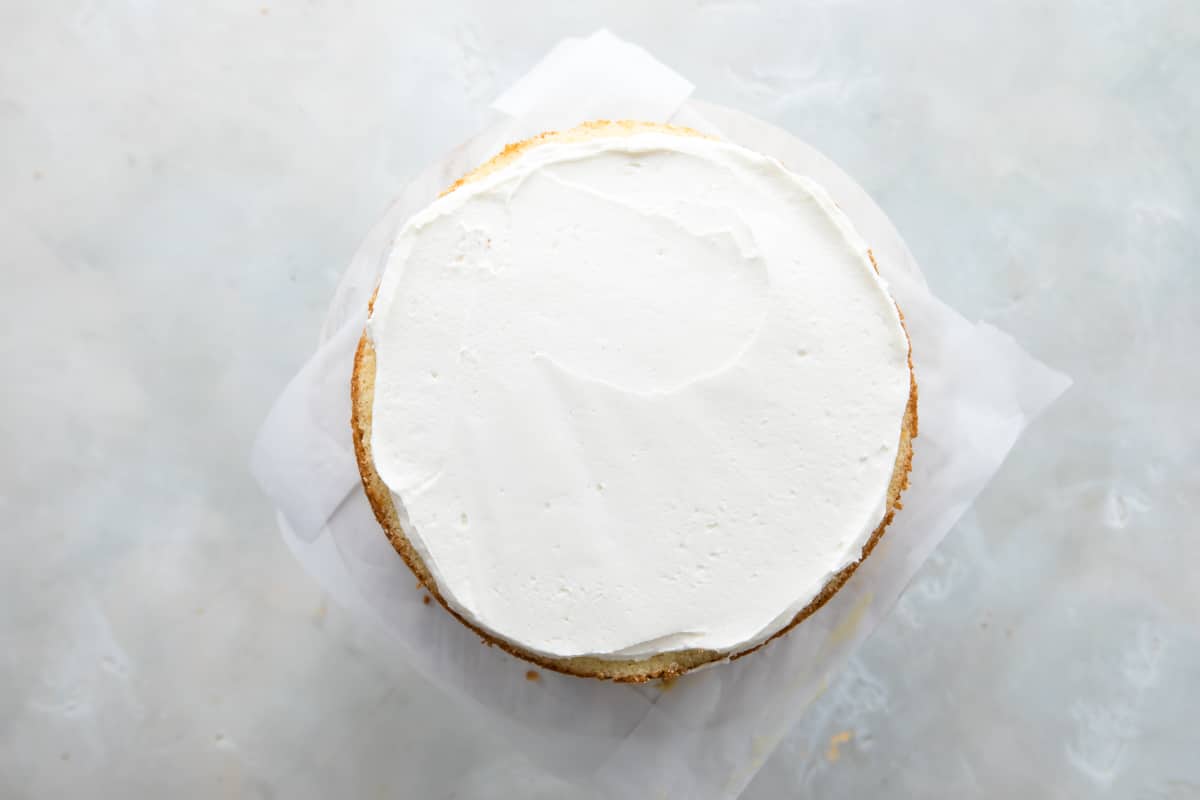
- To frost the sides, gather a few tablespoons of frosting on to the tip of the spatula, then gently spread it onto the side of the cake. Use gentle motions and don’t press too hard or you will end up with crumbs in the frosting. Clean the spatula as needed.
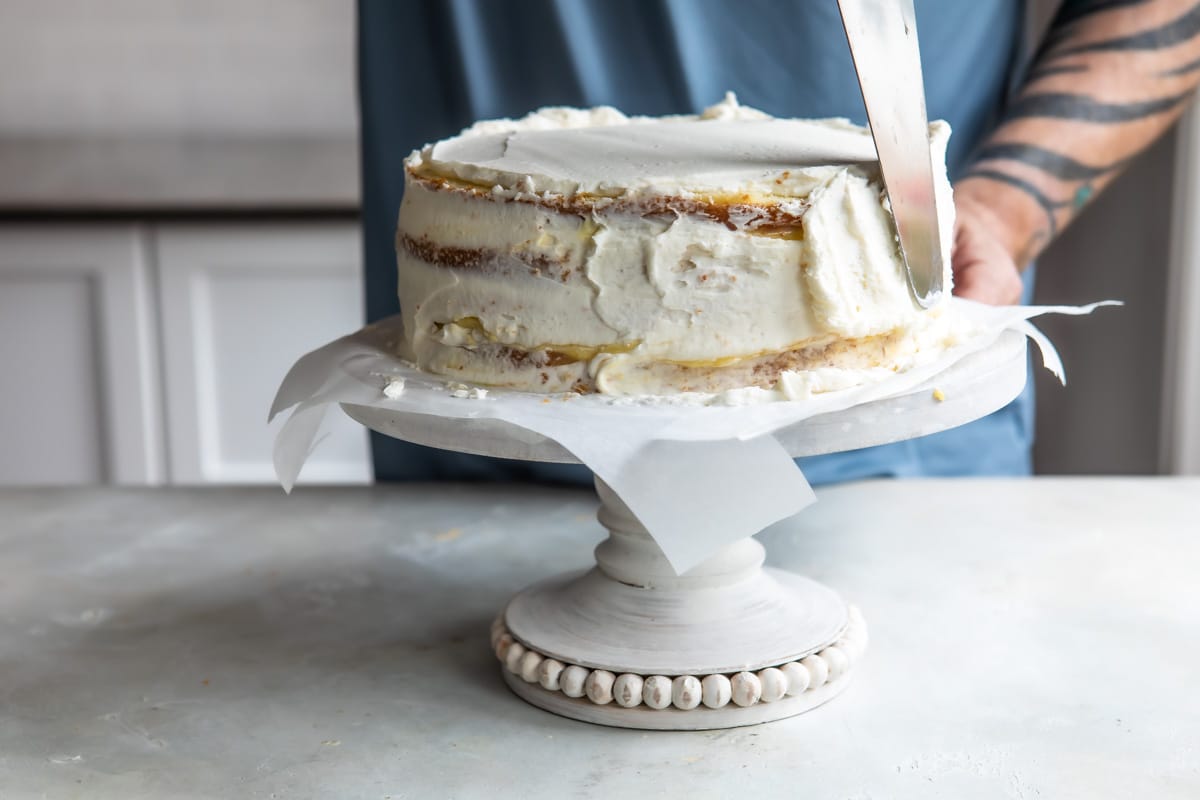
- Gently run the edge of the spatula around the sides to smooth out any bumps and tidy the area where the frosting merges between the sides and the top.
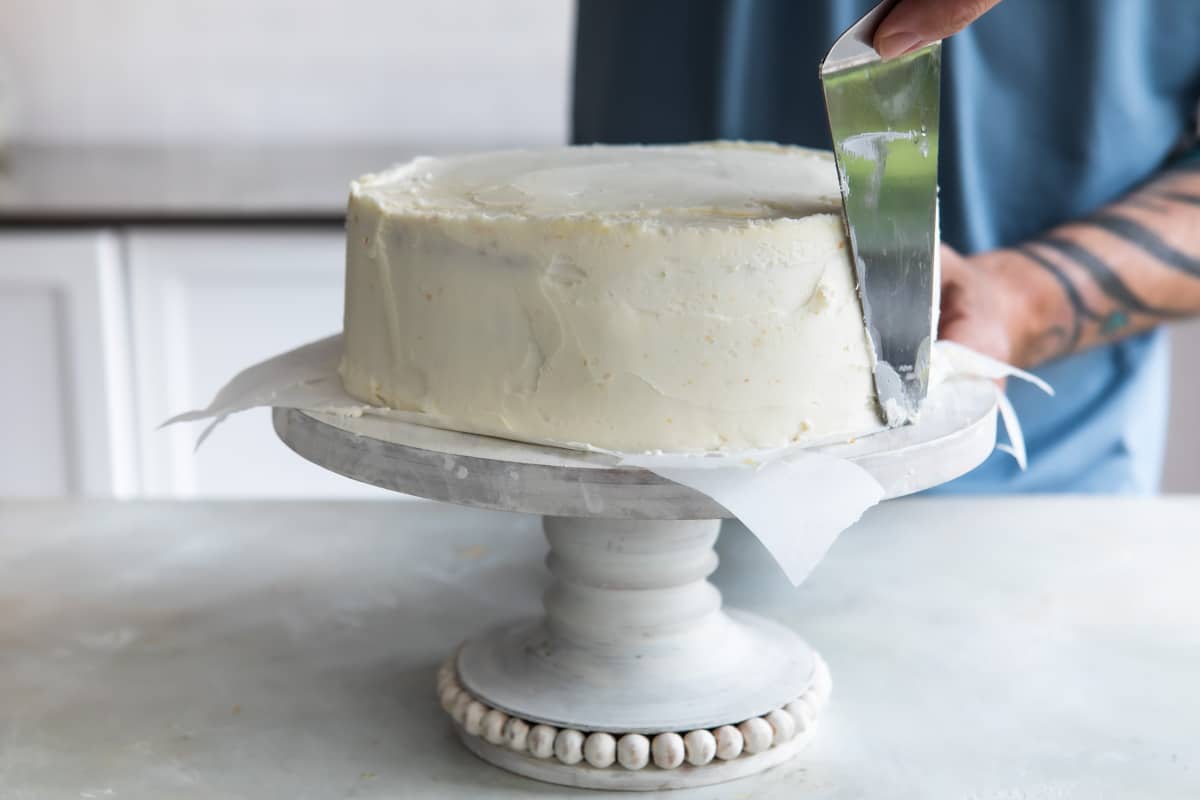
- Decorate the cake as desired with more frosting or some fresh raspberries. Store leftovers in the refrigerator.
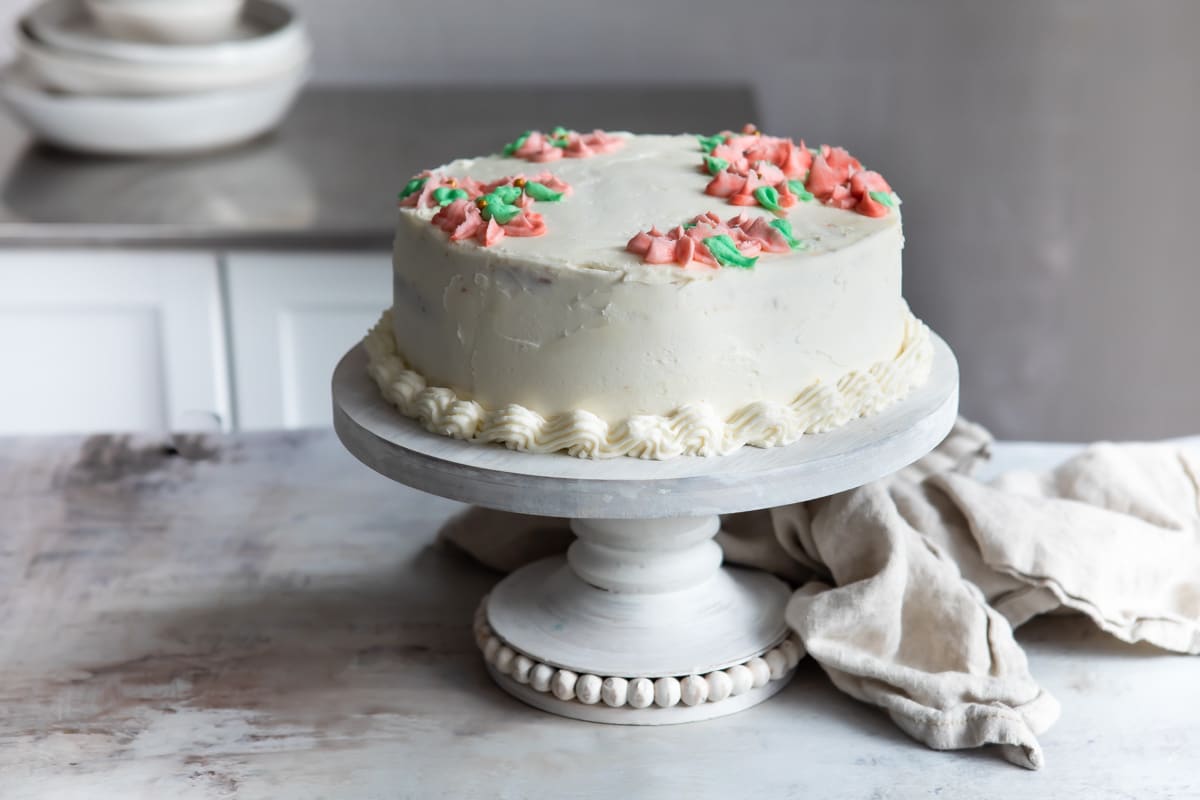
Recipe tips and variations
- Yield: This recipes makes 1 spectacular 4-layer Danish Layer Cake. 1 cake serves 12 (or more or less depending on how you slice it).
- Storage: Store leftover cake in the refrigerator for up to 4 days.
- Make ahead: The pastry cream can be made up to 3 days in advance; whisk to recombine before using. The cake layers can be baked in advance. Cool to room temperature, then wrap tightly in a double layer of plastic wrap, and freeze for up to 3 months. Thaw overnight at room temperature. The vanilla buttercream can be made up to a week in advance; store covered in the refrigerator.
- Freezer: The entire assembled, frosted cake can be frozen for up to 3 months. Thaw for 24 hours in the refrigerator.
- Semi-homemade: I grew up with a not-so-homemade version of Danish Layer Cake, and it was the cake I requested every year for my birthday. It’s delicious and much easier than the from-scratch version below. To make my mom’s version:
- Substitute a boxed yellow cake (prepared according to package directions for 2 (8-inch) cakes) for the from-scratch vanilla cake.
- Substitute a (3.4 ounce) box instant vanilla pudding for the pastry cream. Ignore the package directiosn and make the pudding with 2 cups cold milk (chill at least 10 minutes to set).
- Substitute 16 ounces frozen whipped topping, thawed, for the vanilla buttercream frosting.
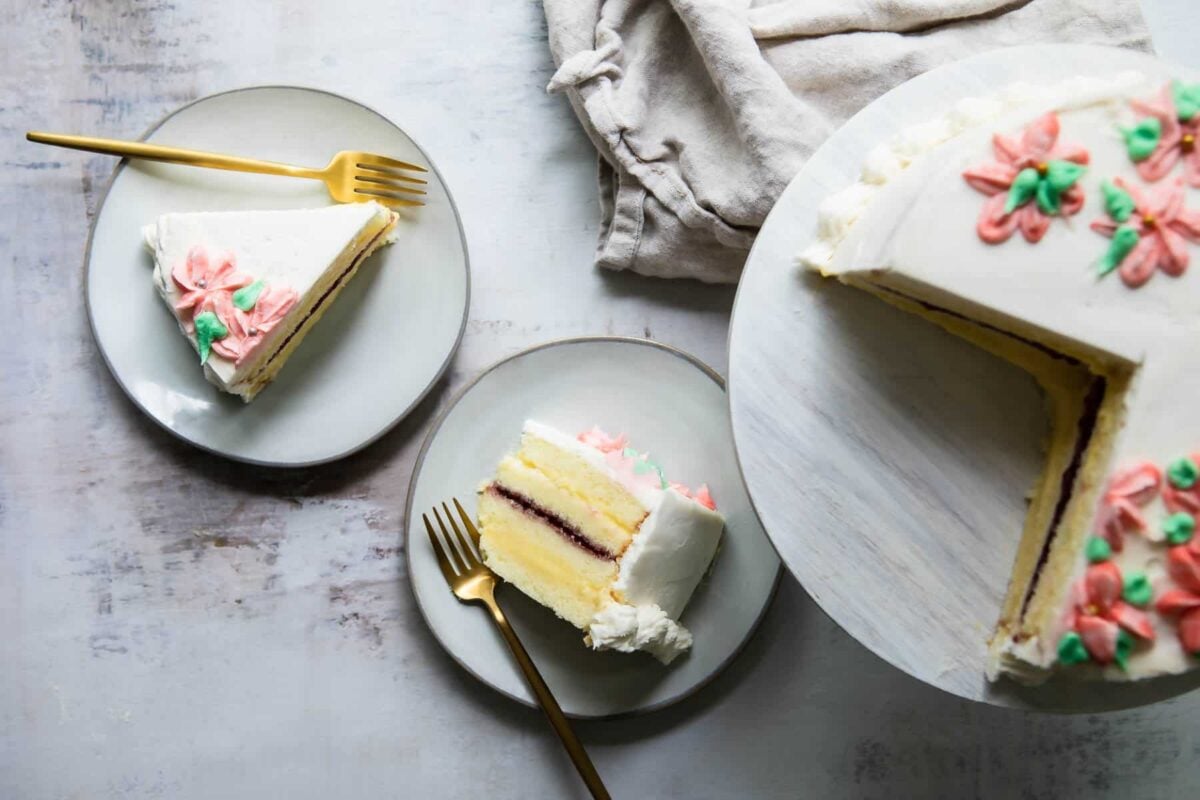
Recipe FAQs
Yes, it does. Danish Layer Cake is made with pastry cream and raspberry jelly, and those are highly-perishable ingredients that need to be kept chilled.
The entire assembled, frosted Danish Layer Cake can be frozen for up to 3 months. Thaw for 24 hours in the refrigerator.
Order handmade Danish Layer Cakes to be shipped throughout the USA from O&H Bakery in Racine, Wisconsin. They also have the best kringles, too!
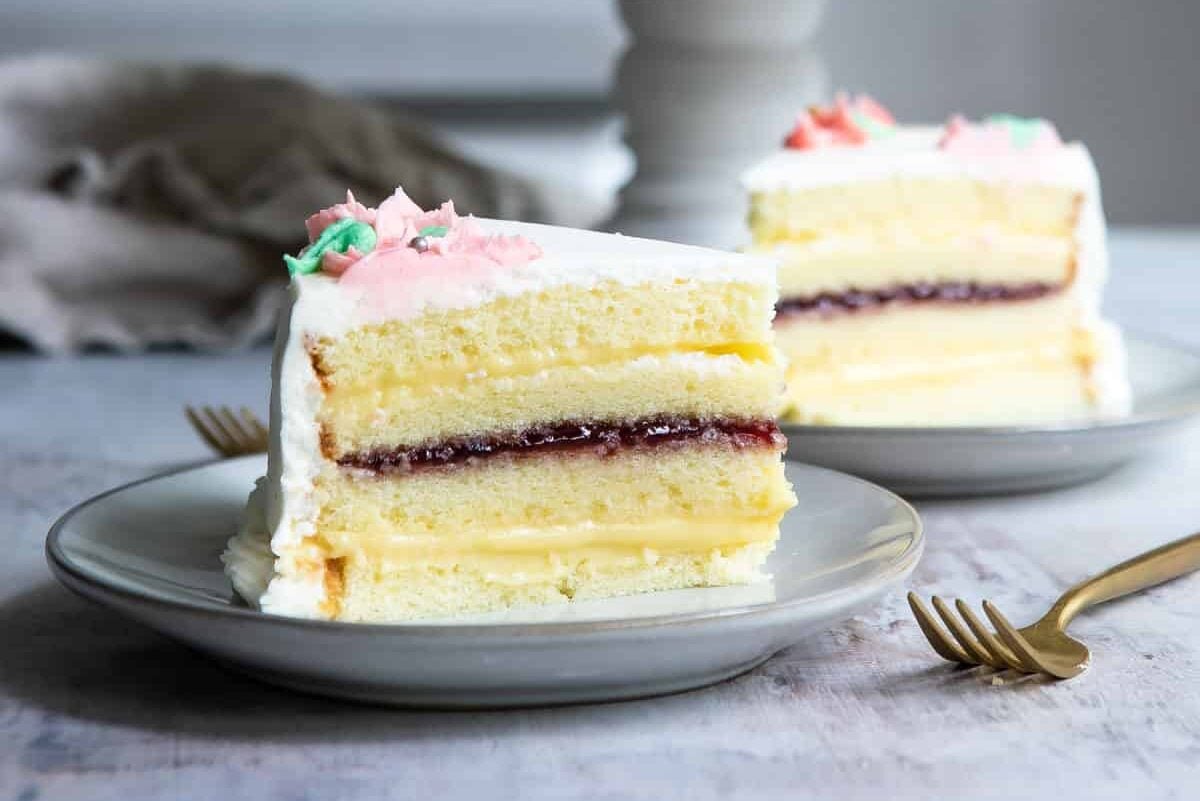
More Wisconsin favorites
Entertaining
Friday Night Fish Fry
Cocktail Recipes
Brandy Old Fashioned
Appetizer Recipes
Fried Cheese Curds
Entertaining
Midwest Charcuterie Board
Join Us
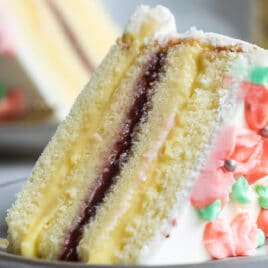
Danish Layer Cake (Dansk Lagekage)
Equipment
- 2 (8-inch) cake pans (see note 1)
Ingredients
For the pastry cream:
- 2 cups milk
- 1 cup granulated sugar
- 6 egg yolks
- 1/4 cup cornstarch
- 1/4 teaspoon salt
- 1 teaspoon vanilla extract
For the yellow cake:
- 1/2 cup whole milk at room temperature (see note 2)
- 4 large eggs at room temperature
- 2 teaspoons vanilla extract
- 1 3/4 cups cake flour (7 ounces)
- 1 1/2 cups granulated sugar (10 ½ ounces)
- 2 teaspoons baking powder
- 3/4 teaspoon Salt
- 1 cup unsalted butter cut into tablespoons and softened (2 sticks)
For the buttercream frosting:
- 1 cup butter softened (2 sticks)
- 4 to 5 cups powdered sugar
- 2 teaspoons vanilla extract
- 1/4 cup heavy cream
- Pinch Salt optional
To assemble the cake:
- 1 small jar seedless raspberry jam (see note 3)
- Fresh raspberries for garnish optional
Instructions
To make the pastry cream:
- In a medium non-aluminum saucepan over medium heat, warm milk until tiny bubbles appear on the surface, about 6 to 8 minutes (about 180 degrees Fahrenheit/82 degrees Celsius).
- Meanwhile, In a large bowl, whisk together egg yolks and sugar. Whisk in cornstarch and salt.
- While whisking constantly, pour in half of the hot milk. Whisk in remaining hot milk and return to saucepan.
- Cook over medium heat, whisking constantly, until the mixture thickens to a firm consistency, about 5 to 8 minutes. Whisk in vanilla. Scrape in to a bowl.
- Cover with plastic wrap, pressing it directly on to the surface of the pastry cream. Refrigerate until chilled, about 2 to 3 hours. (Note: You will have just over 2 cups of pastry cream and you only need about 1 ½ cups for this recipe.)
To make the cake:
- Preheat oven to 350 degrees. Grease and flour 2 (8-inch) round cake pans, then line parchment paper. In a small bowl, whisk together milk, eggs, and vanilla. Set aside.
- In the bowl of a standing mixer fit with the whisk attachment, beat together flour, sugar, baking powder, and salt.
- With the mixer on medium-low speed, beat the butter in to the flour mixture one piece at a time. Continue beating until the mixture resembles moist crumbs, 1 to 3 minutes total.
- Add the milk mixture to the mixer and beat until light and fluffy, 1 to 3 minutes longer. Stir by hand with a rubber spatula to make sure the batter is fully combined.
- Divide the batter evenly between both pans, gently tapping the pans on the counter to settle the batter. Bake until a toothpick inserted in the center of the cake comes out dry with a few crumbs attached, 20 to 25 minutes. Rotate the pans halfway through baking time.
- Cool the cakes in the pans for 10 minutes. Run a small sharp knife around the inside of each pan to loosen, then flip the cakes on to a wire rack. Peel off the parchment paper, then flip the cakes right side up to cool completely, about 2 hours.
To make the frosting:
- In a standing mixer fit with the paddle attachment, cream butter until pale and fluffy, about 3 minutes.
- Reduce mixer speed to low. Add 4 cups powdered sugar, cream, vanilla, and salt (if using). Continue mixing 2 to 3 minutes longer. If the frosting seems too soft, add the remaining powdered sugar 2 tablespoons at a time.
- Cover and refrigerate the frosting until assembling the cake, up to 1 week in advance.
To assemble the cake:
- Slice off any domed tops of your cake to ensure they are flat. Cut each cooled cake in half lengthwise so there are four layers of cake total.
- Cover the edges of a cake platter with strips of parchment paper to help keep it clean. Slide the pieces of parchment out from under the cake once the frosting job is done.
- Dollop a small amount of frosting in the center of the platter to help anchor the bottom of the cake to the platter (so it doesn't slide around as you frost it).
- Add one layer of cake to the serving platter. Add ¾ cup of the pastry cream to the center of the cake and spread in an even layer to the edge. Align a second layer of cake over the first and top with 1 cup raspberry jam, spreading in an even layer to the edge.
- Add a third layer of cake and top with ¾ cup of pastry cream in the center, spreading in an even layer to the edge. Top with the last layer of cake. Brush away any large crumbs, dollop frosting in the center, and spread lightly to the edges.
- To frost the sides, gather a few tablespoons of frosting on to the tip of the spatula, then gently spread it onto the side of the cake. Use gentle motions and don't press too hard or you will end up with crumbs in the frosting. Clean the spatula as needed.
- Gently run the edge of the spatula around the sides to smooth out any bumps and tidy the area where the frosting merges between the sides and the top.
- Decorate the cake as desired with more frosting or some fresh raspberries. Store leftovers in the refrigerator.
Notes
- 8-inch cake pans: Do not substitute 9-inch cake pans.
- Whole milk: Do not substitute low-fat milk for the whole milk in the vanilla cake.
- Seedless raspberry jam: If you cannot track this down, raspberry jam with seeds, or another seedless jam, may be substituted. Strawberry seedless jam tastes great in this cake.
- Yield: This recipes makes 1 spectacular 4-layer Danish Layer Cake. 1 cake serves 12 (or more or less depending on how you slice it).
- Storage: Store leftover cake in the refrigerator for up to 4 days.
- Make ahead: The pastry cream can be made up to 3 days in advance; whisk to recombine before using. The cake layers can be baked in advance. Cool to room temperature, then wrap tightly in a double layer of plastic wrap, and freeze for up to 3 months. Thaw overnight at room temperature. The vanilla buttercream can be made up to a week in advance; store covered in the refrigerator.
- Freezer: The entire assembled, frosted cake can be frozen for up to 3 months. Thaw for 24 hours in the refrigerator.
Nutrition
Meggan Hill is a classically-trained chef and professional writer. Her meticulously-tested recipes and detailed tutorials bring confidence and success to home cooks everywhere. Meggan has been featured on NPR, HuffPost, FoxNews, LA Times, and more.


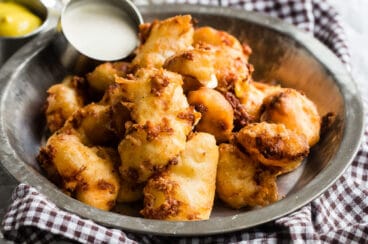

Let’s say I’m a glutton for pastry cream and want to double it. Any thoughts on issues that might arise? Is the cream thick enough to hold in place?
Hi Scott, thank you for your question! I haven’t tried doubling the pastry cream layers myself. I would worry about the cake layers sliding. If you do attempt it, I would be sure that the cake layers are completely cool, and would make the pastry cream the day before and refrigerate it overnight. I would then pipe a ring around the edge of the cake and fill in the pastry cream, rather than just spreading it. I hope you find this helpful, and please write back if you try it! – Meggan
OMG this cake is to die for! I also grew up in Racine and this cake was a must have!
I tried to make this recipe last night, and I want to stress that it’s very important the butter is ‘soft’ before you add it to the batter. Mine was not, and did not get incorporated well. This led to poor rising. A second attempt was done with softer batter, and it came out much nicer. Rose a lot more.
However, both of my cakes came out underdone. I cooked the first batch for about 25 minutes, the second for 28. Toothpicks came out clean both times, and the edges were pulling away from the pan, (so it almost looked overdone at that time). I pulled them out, let them cool a bit, then went to flip them, and found raw middles both times. I do not know what happened! It was very frustrating. This same oven made a box mix of cake the same night just fine.